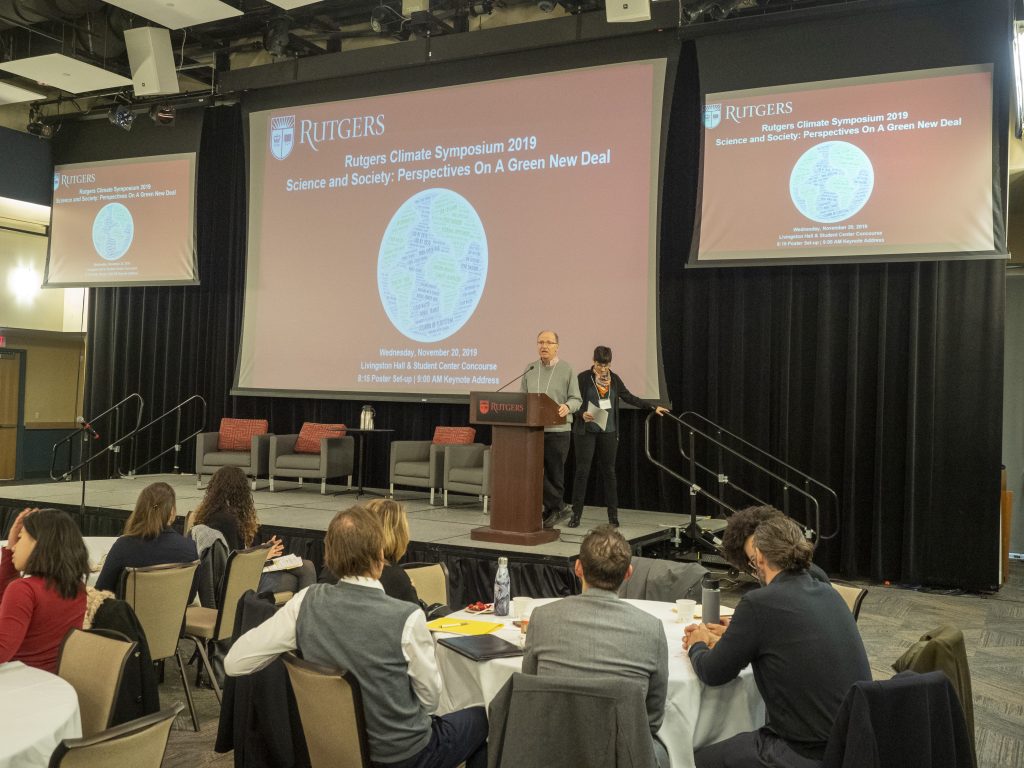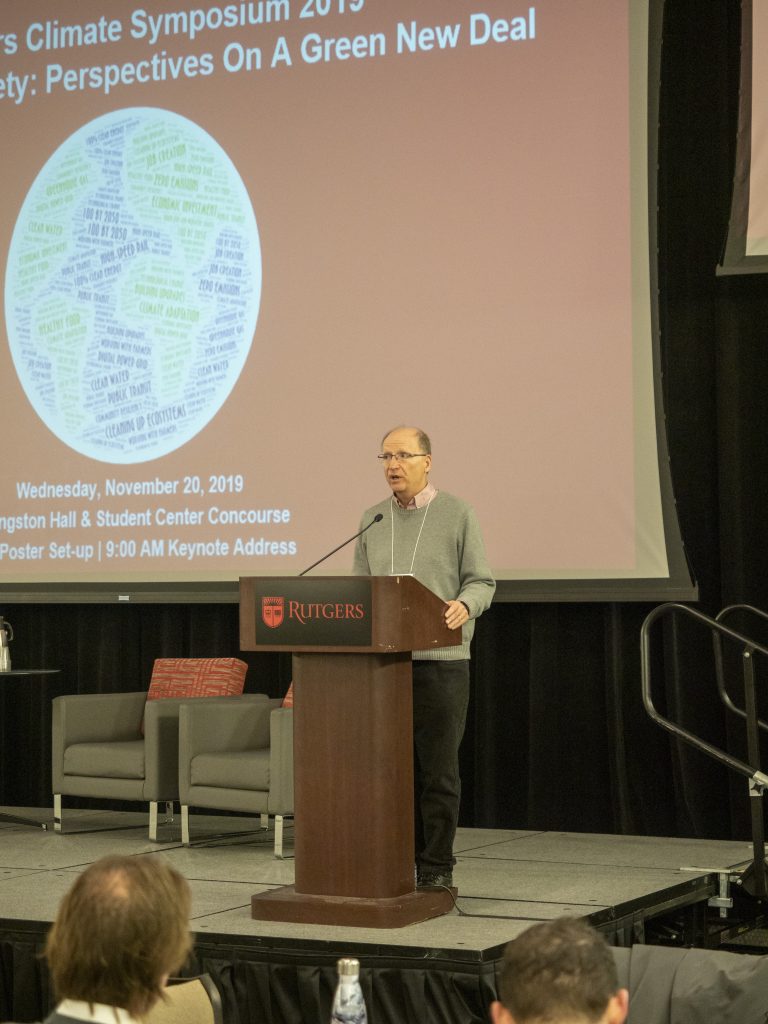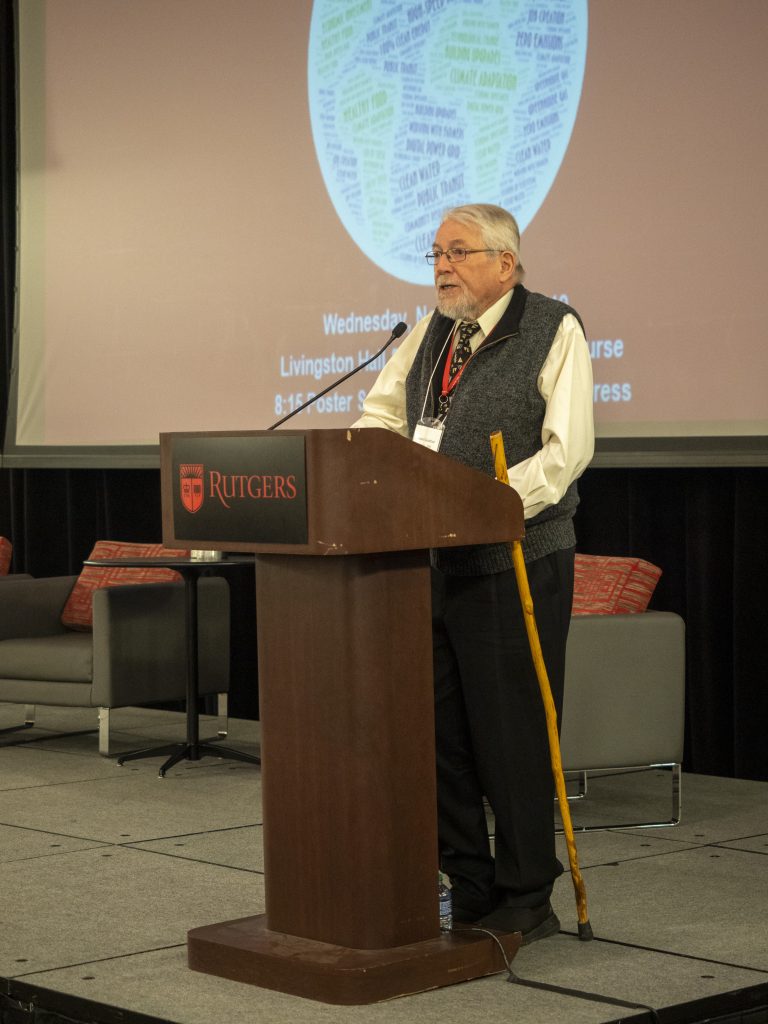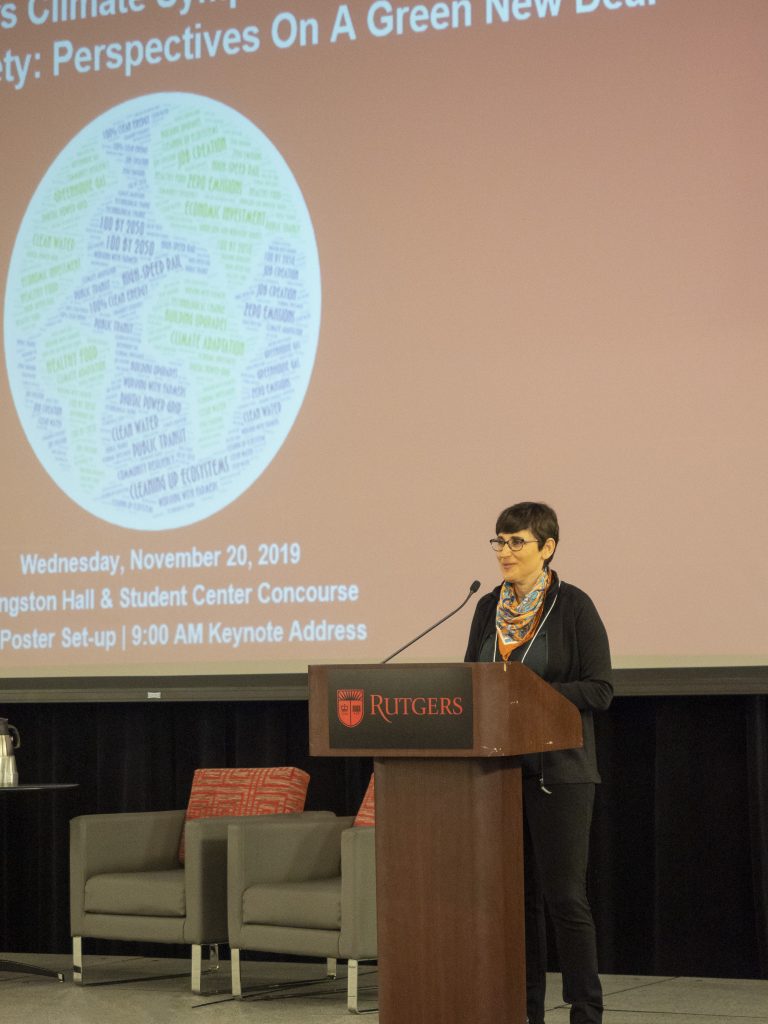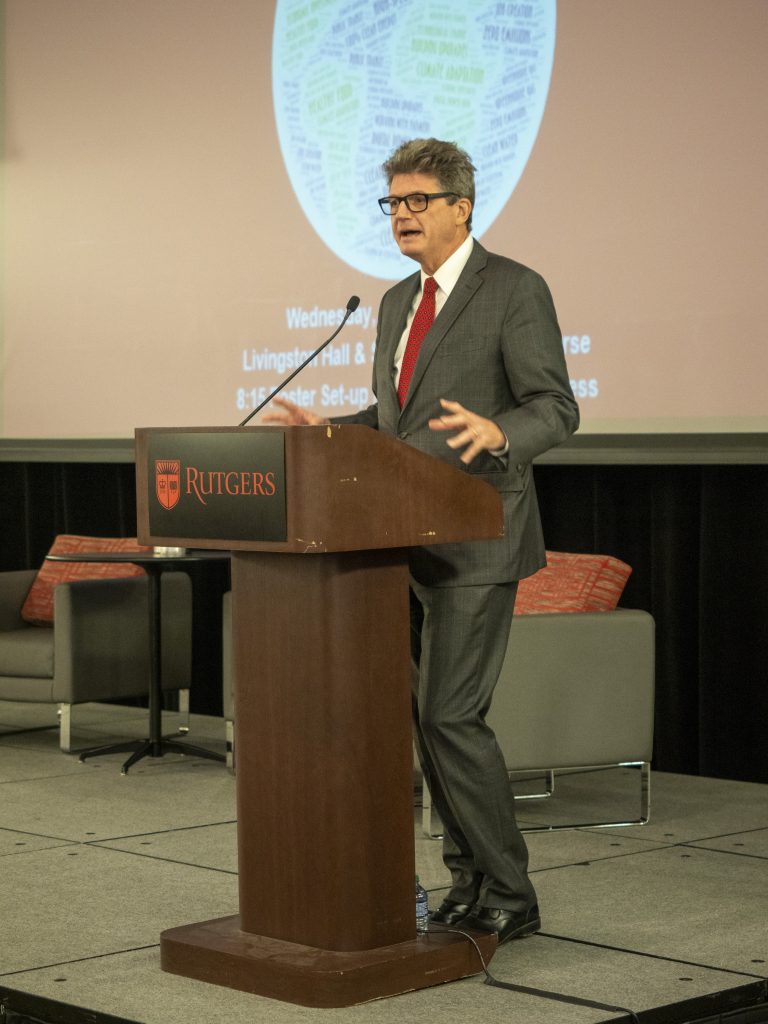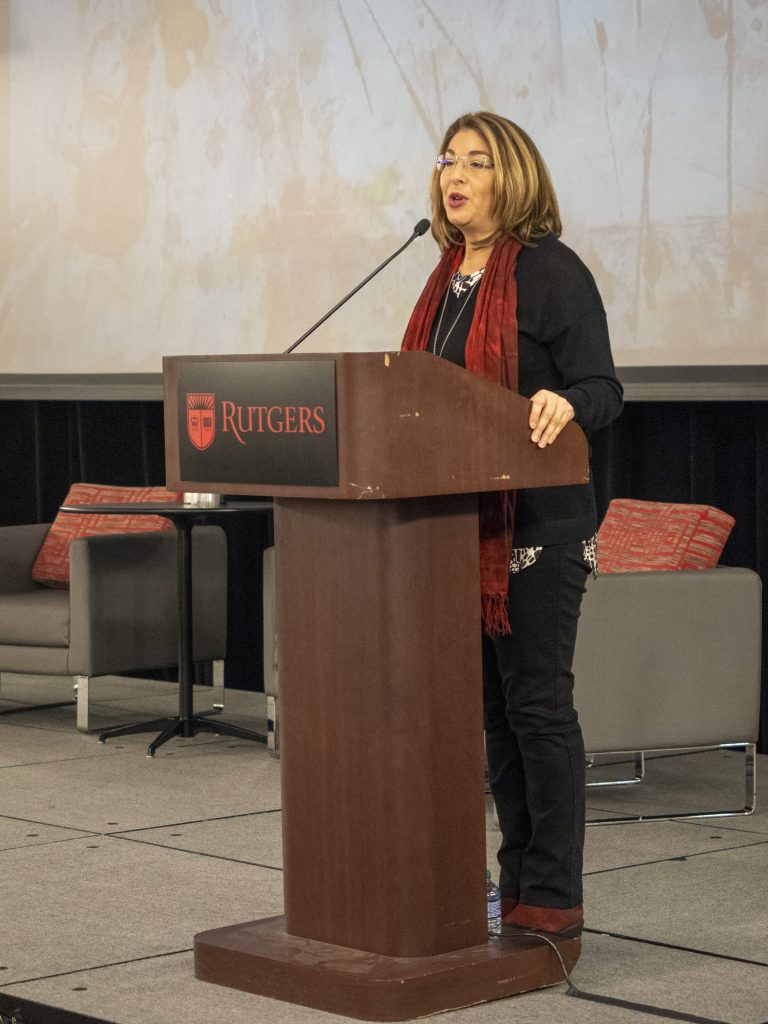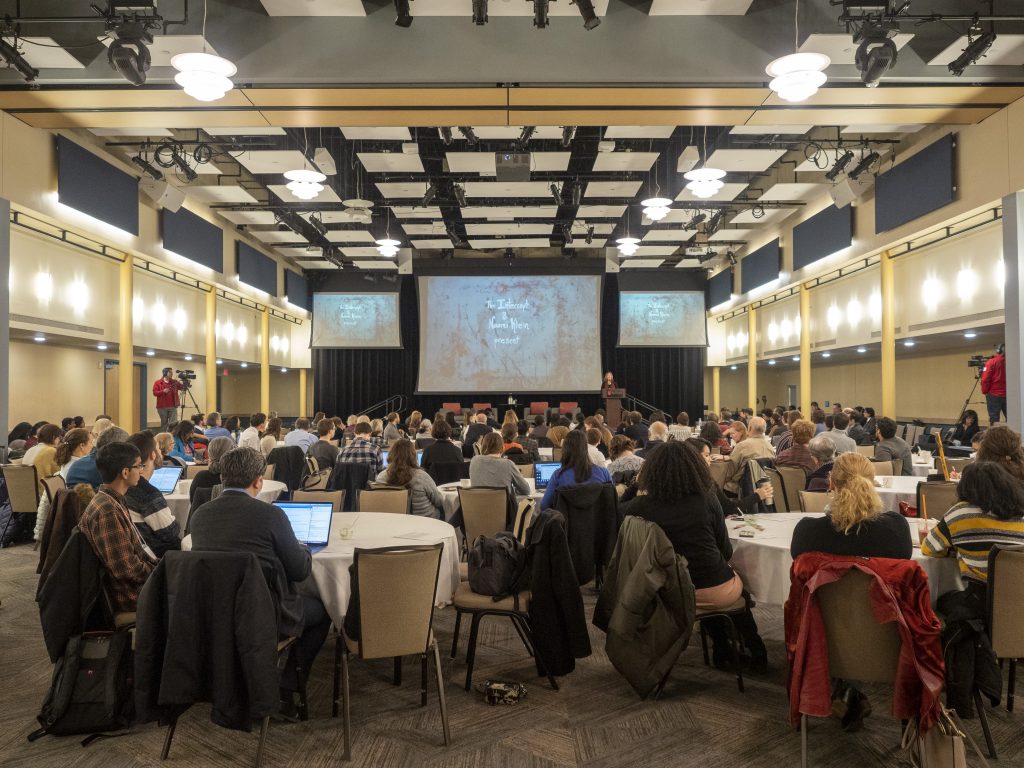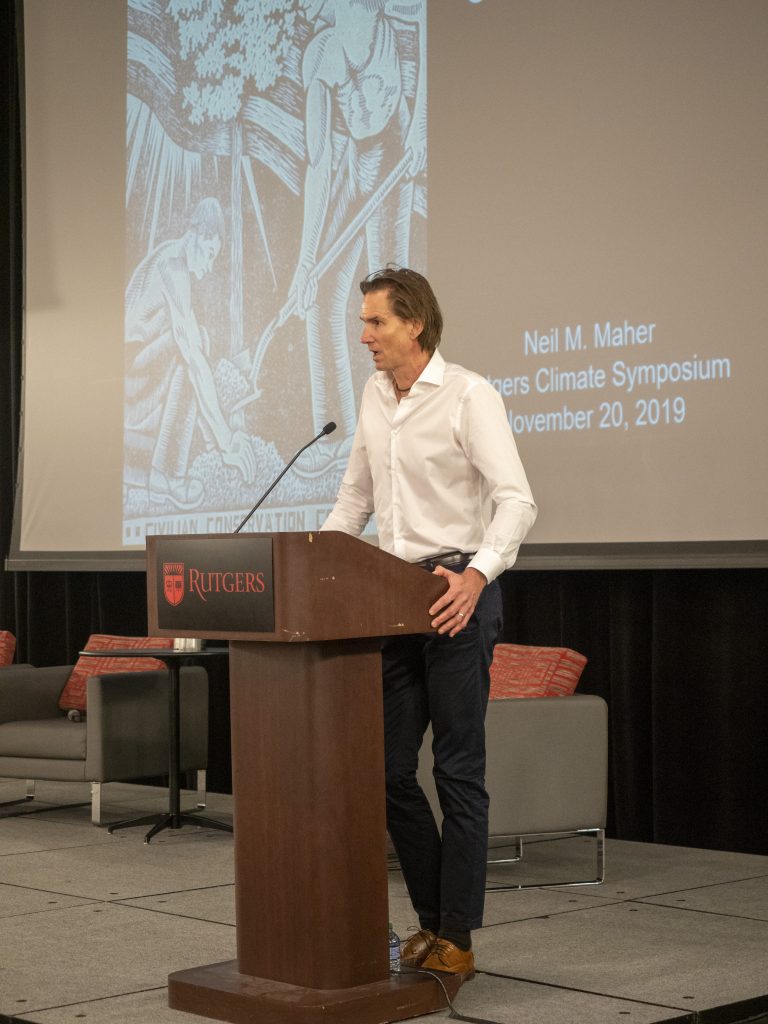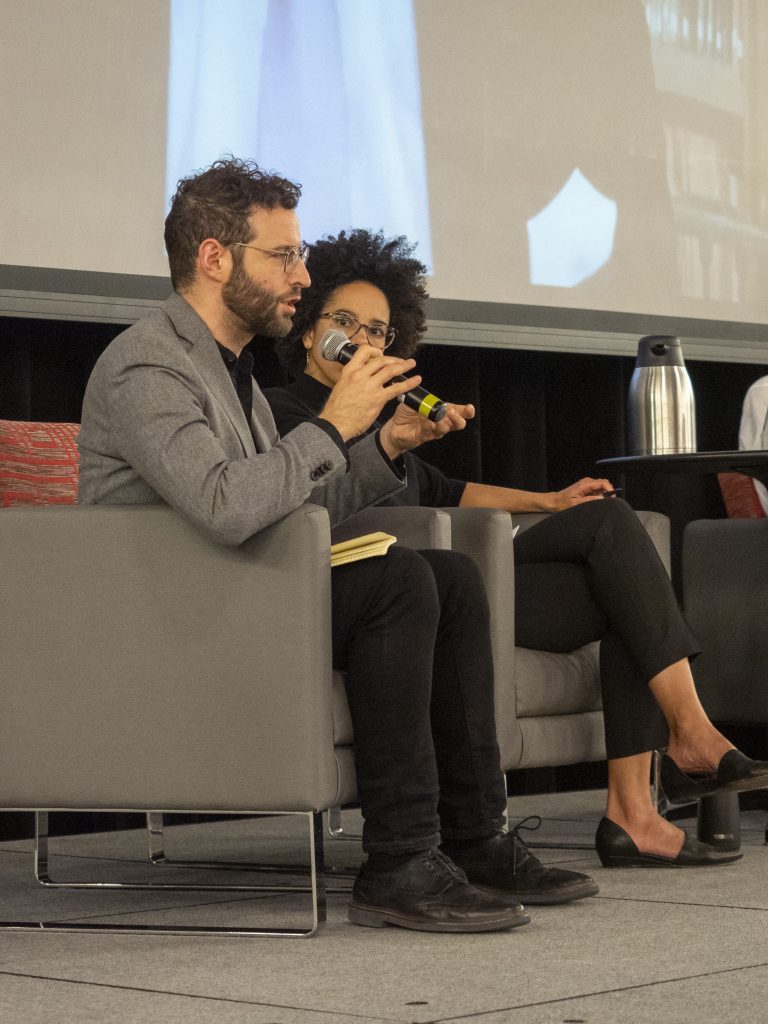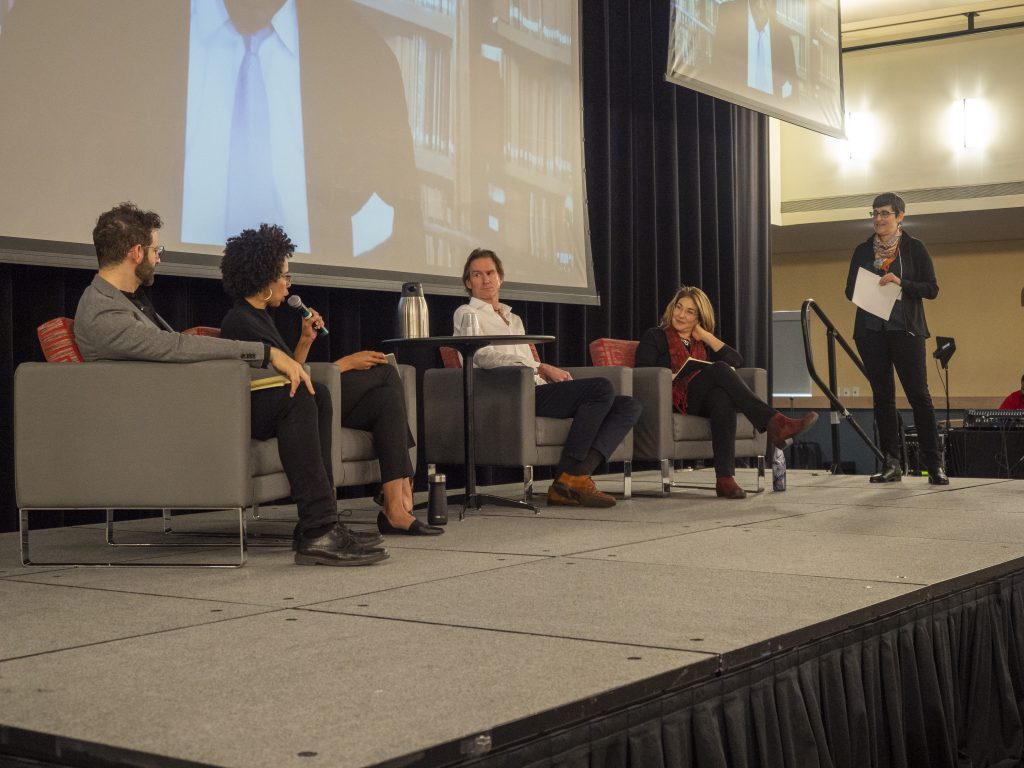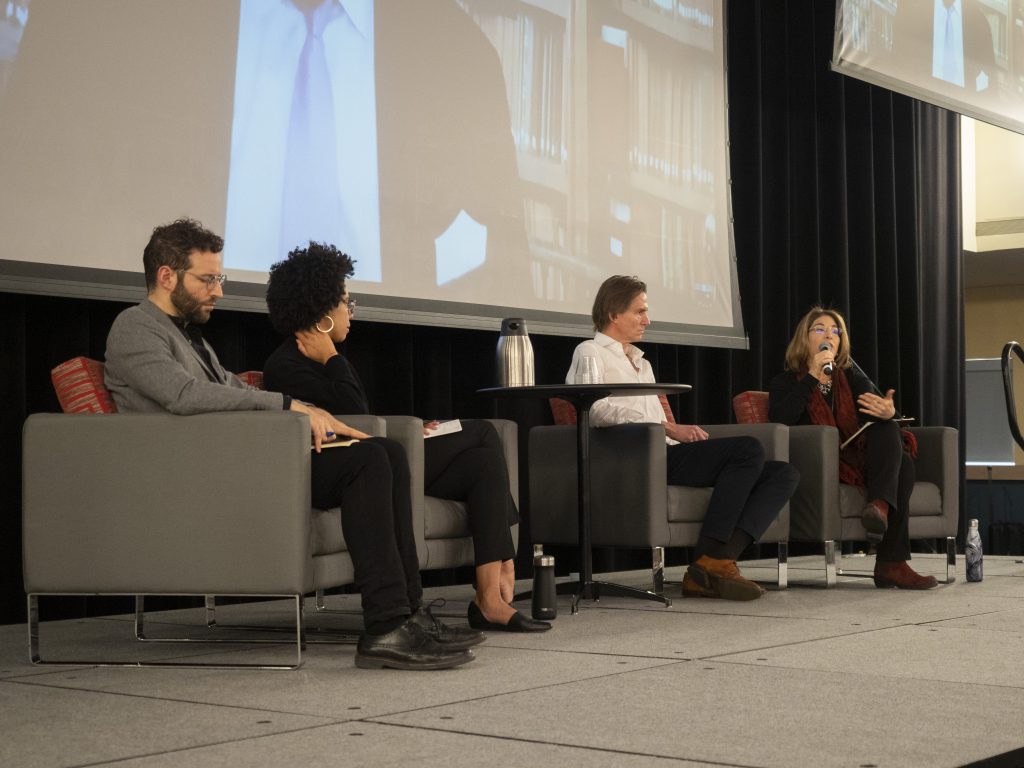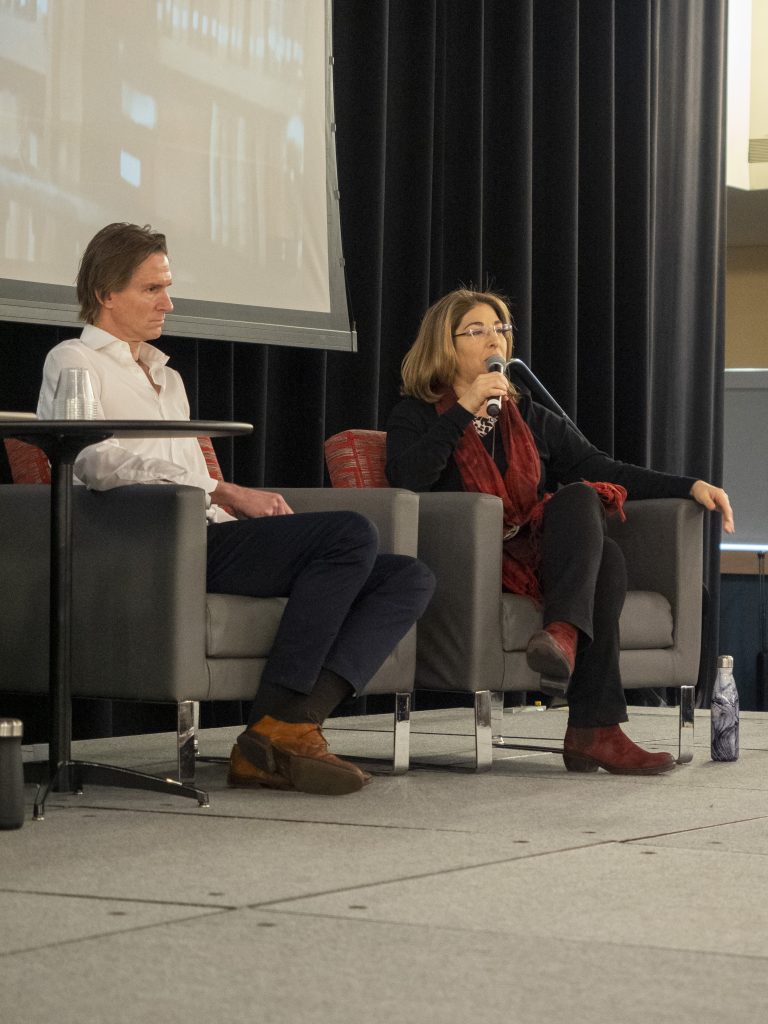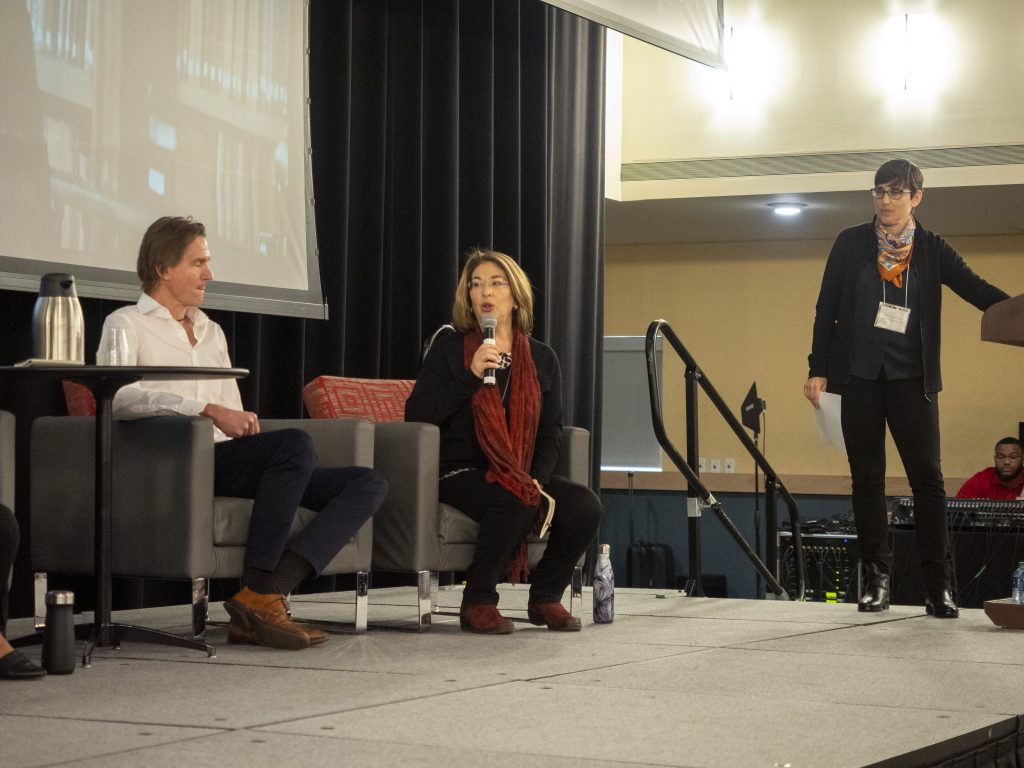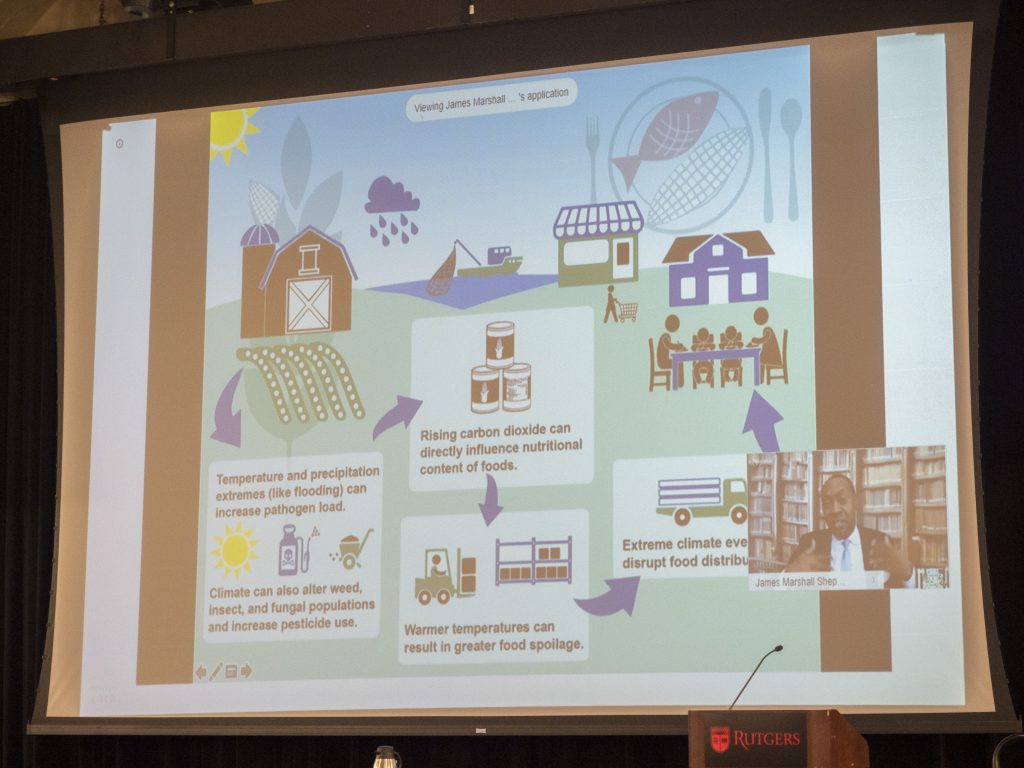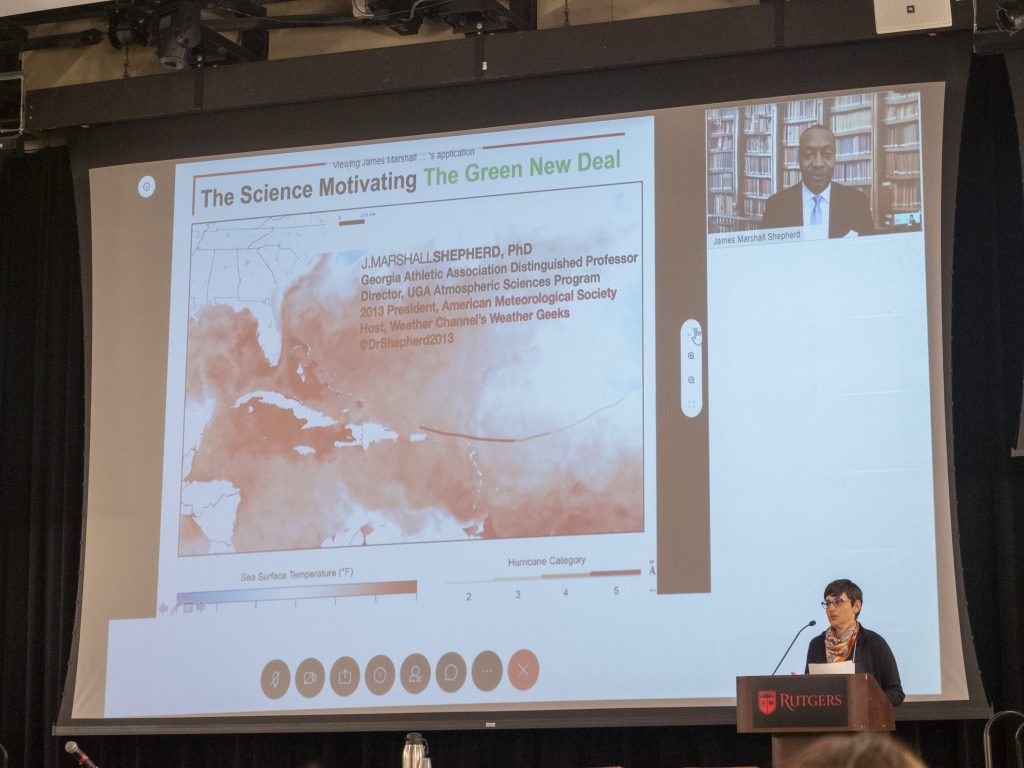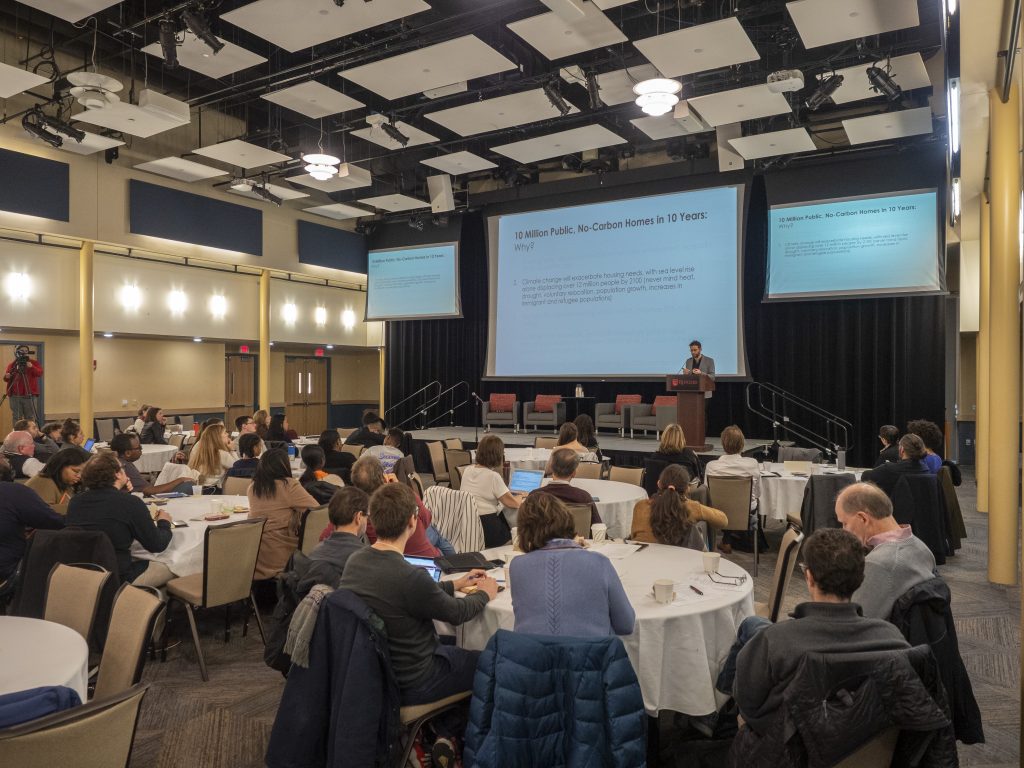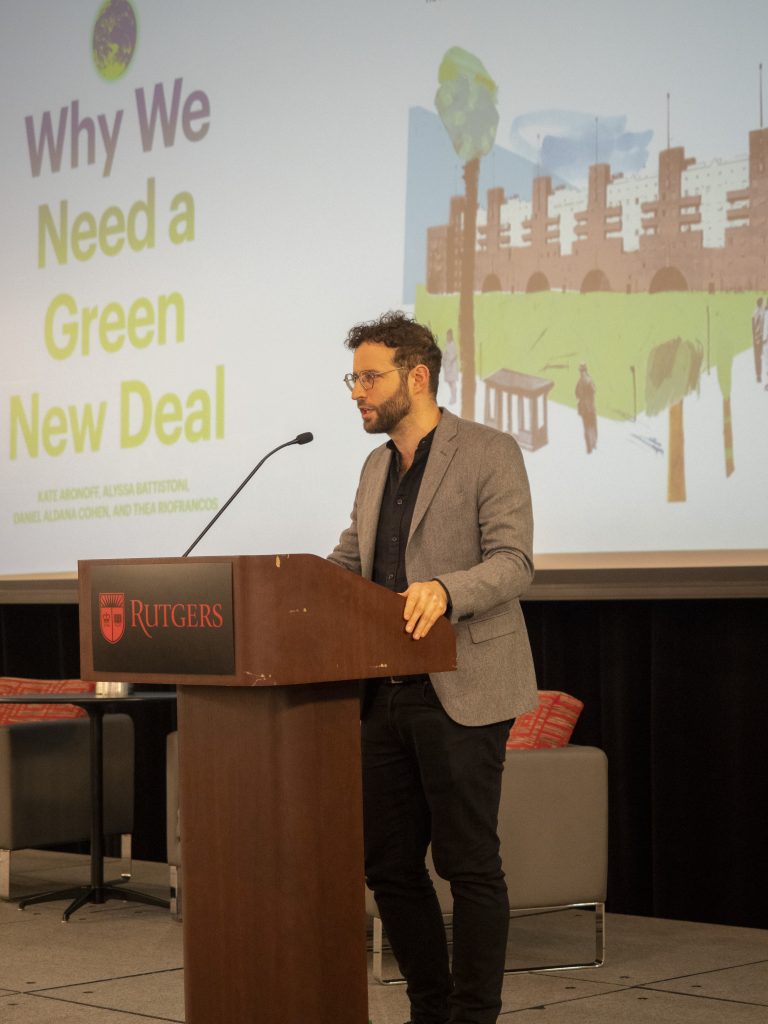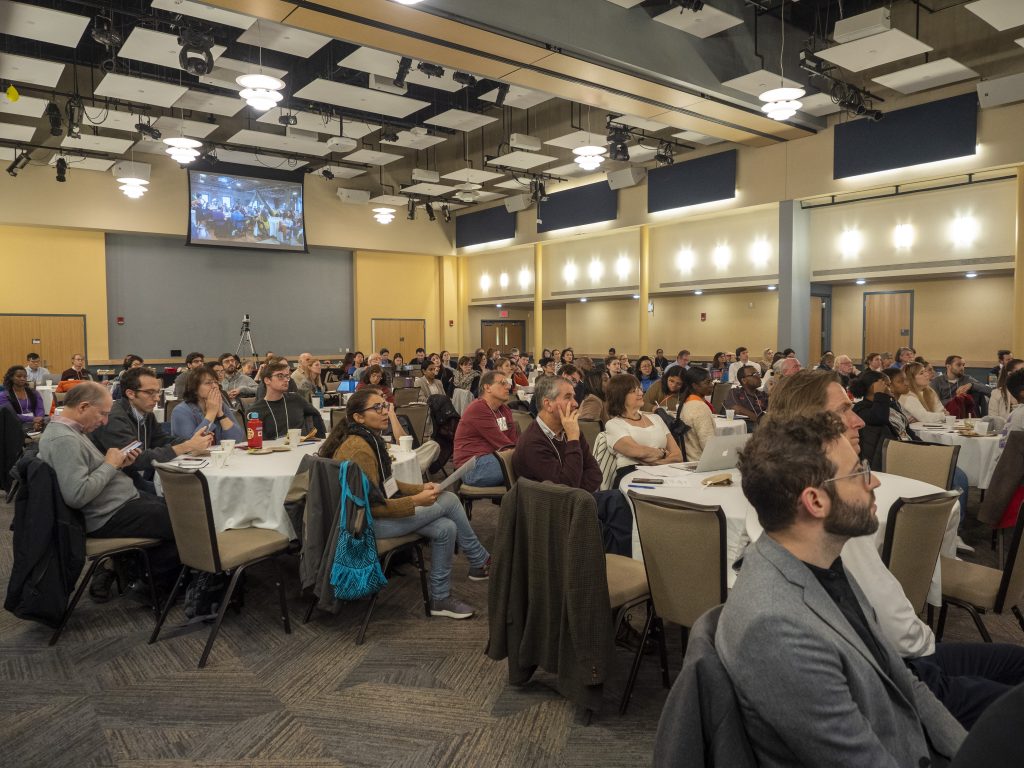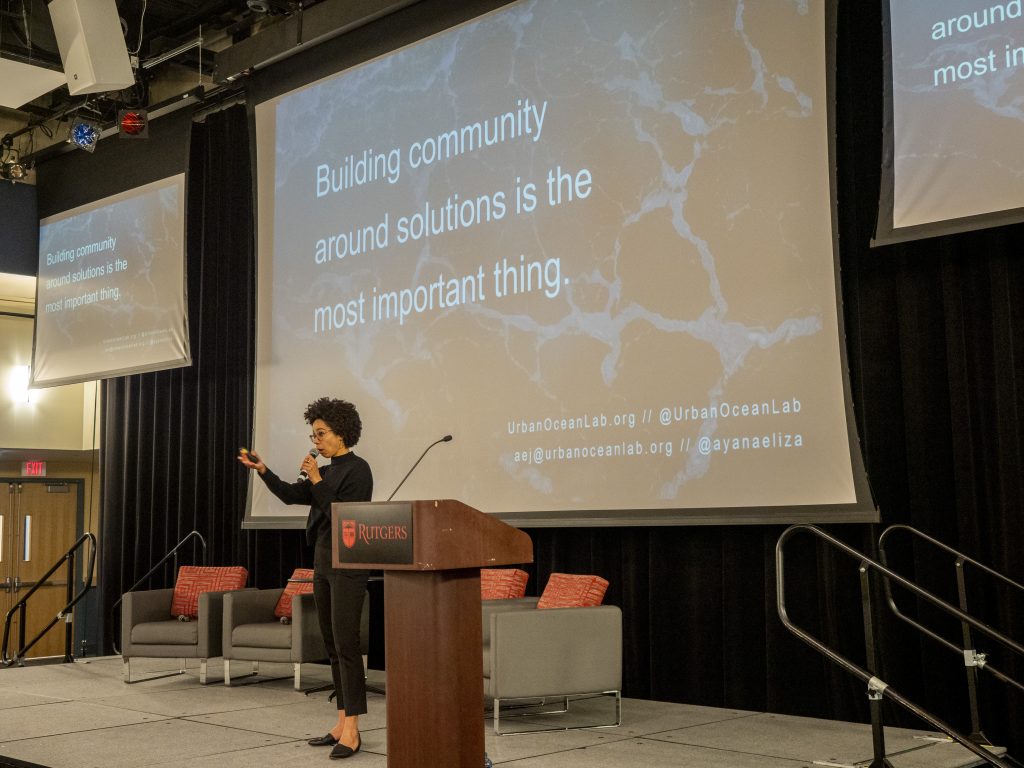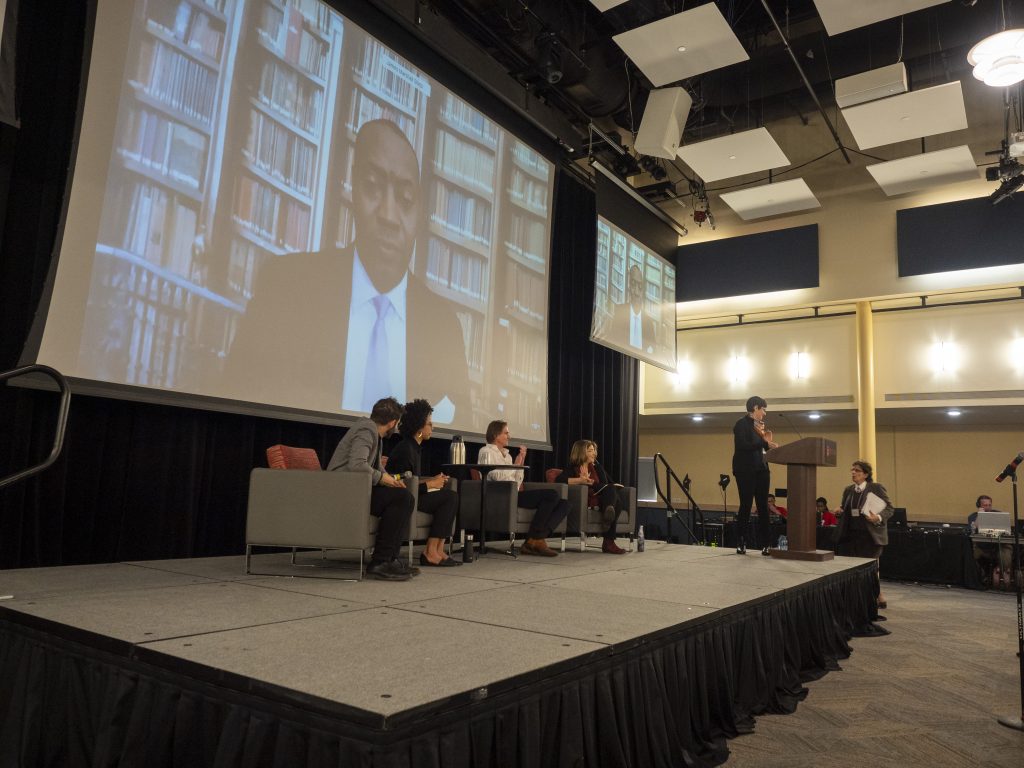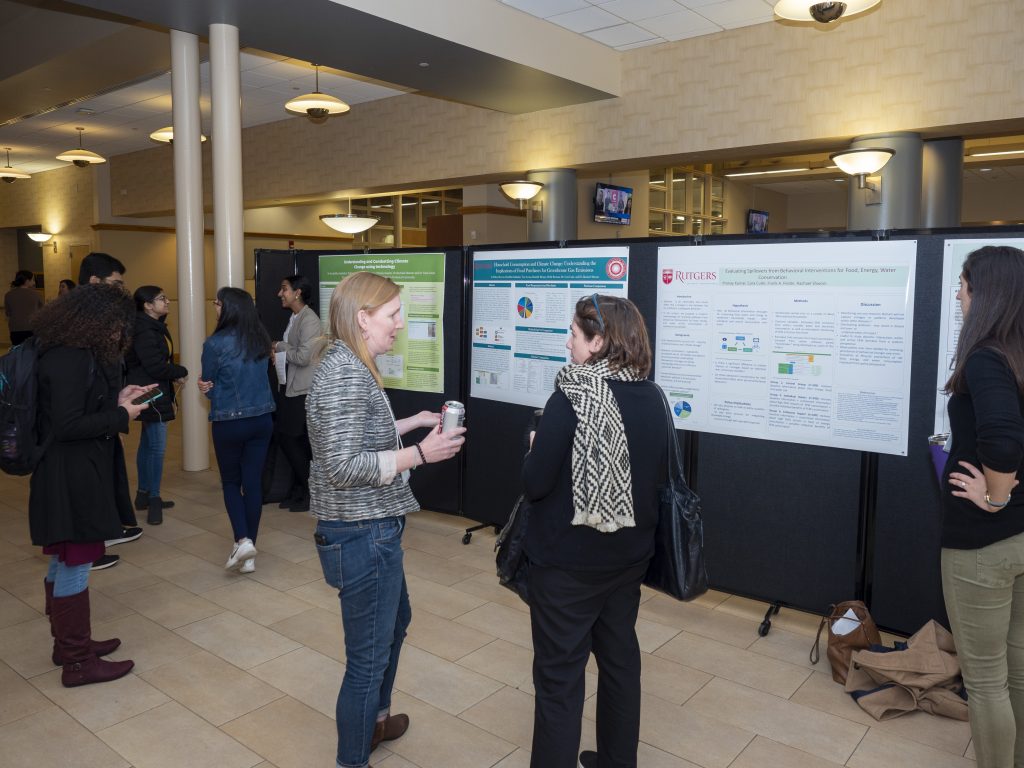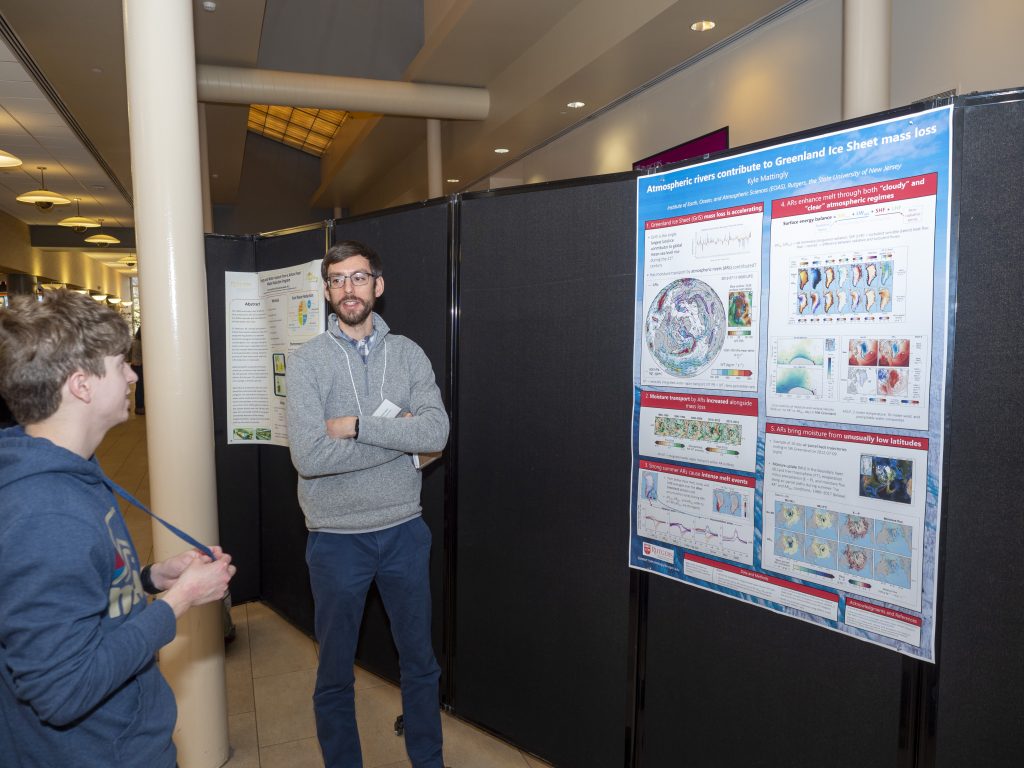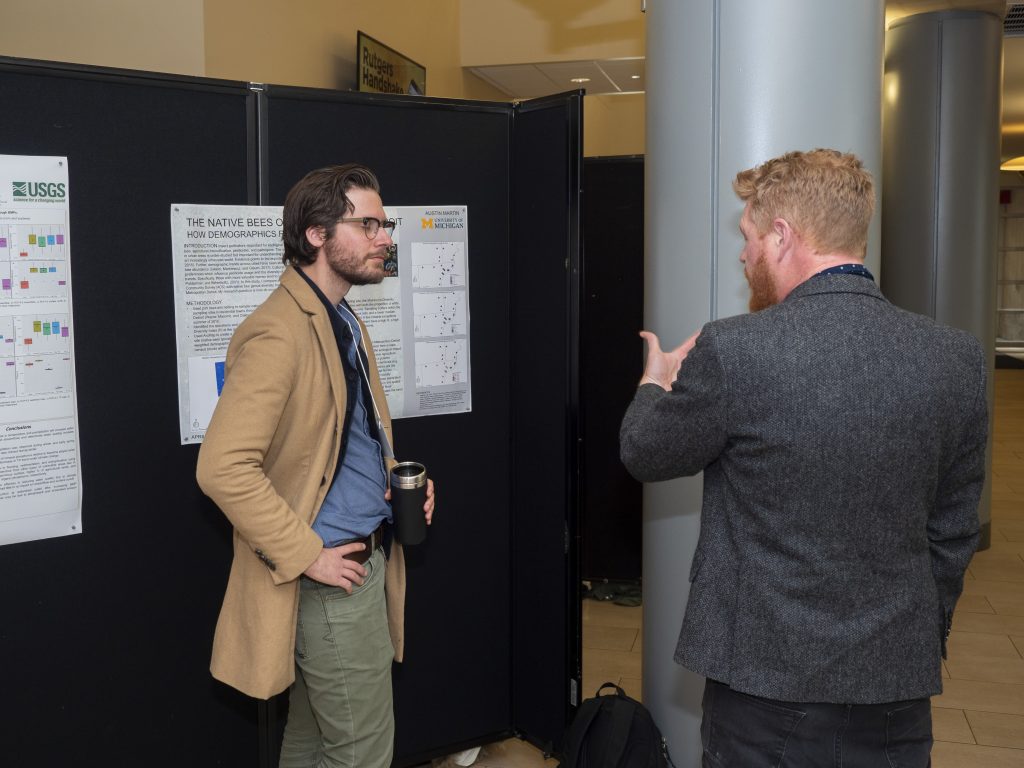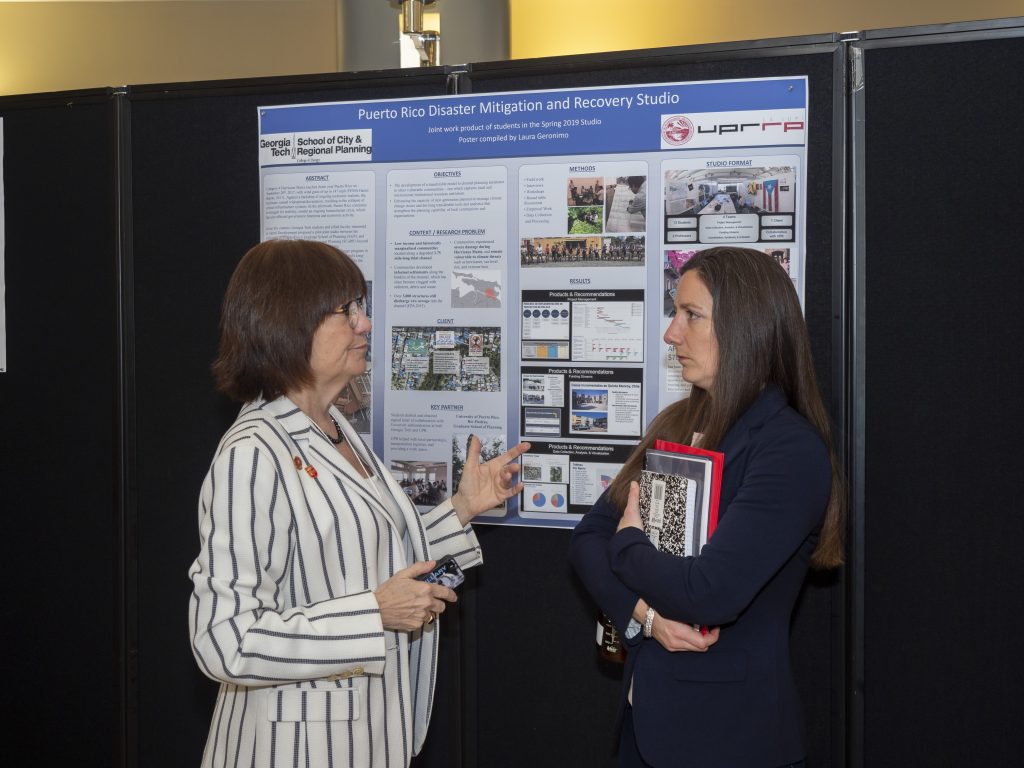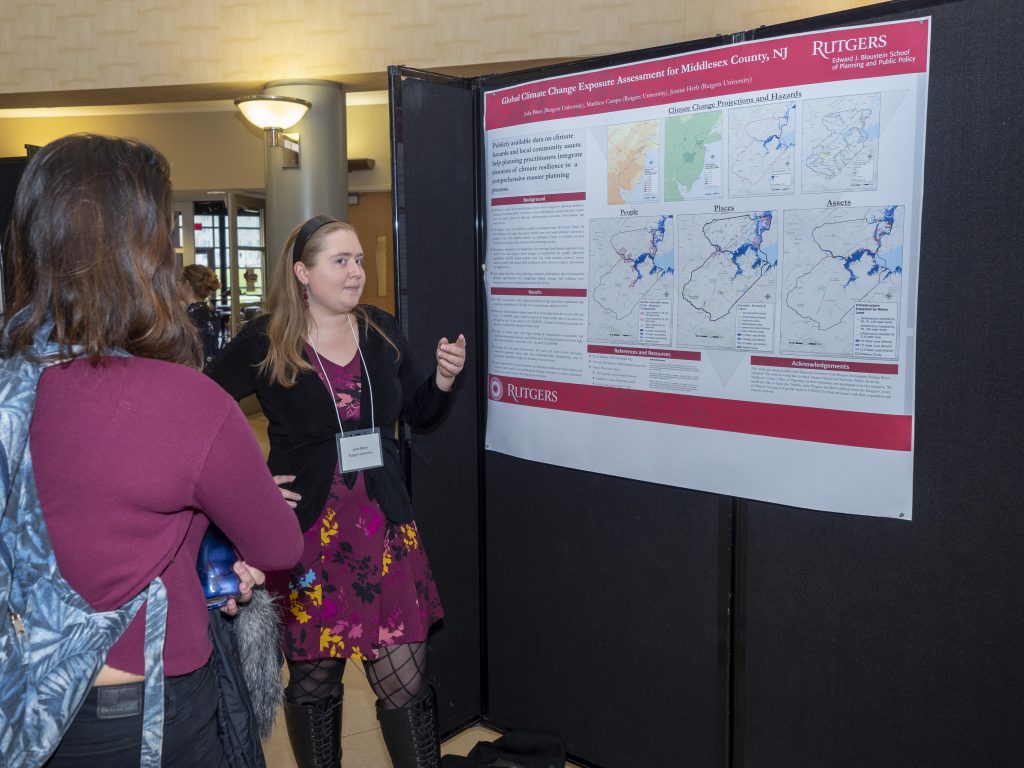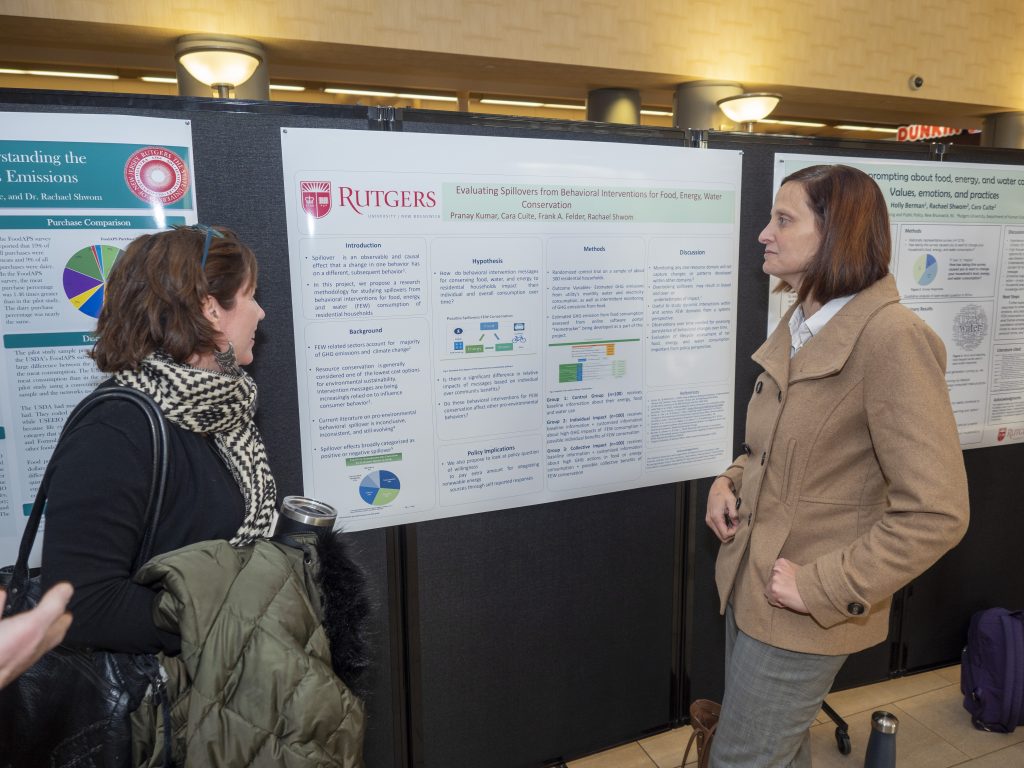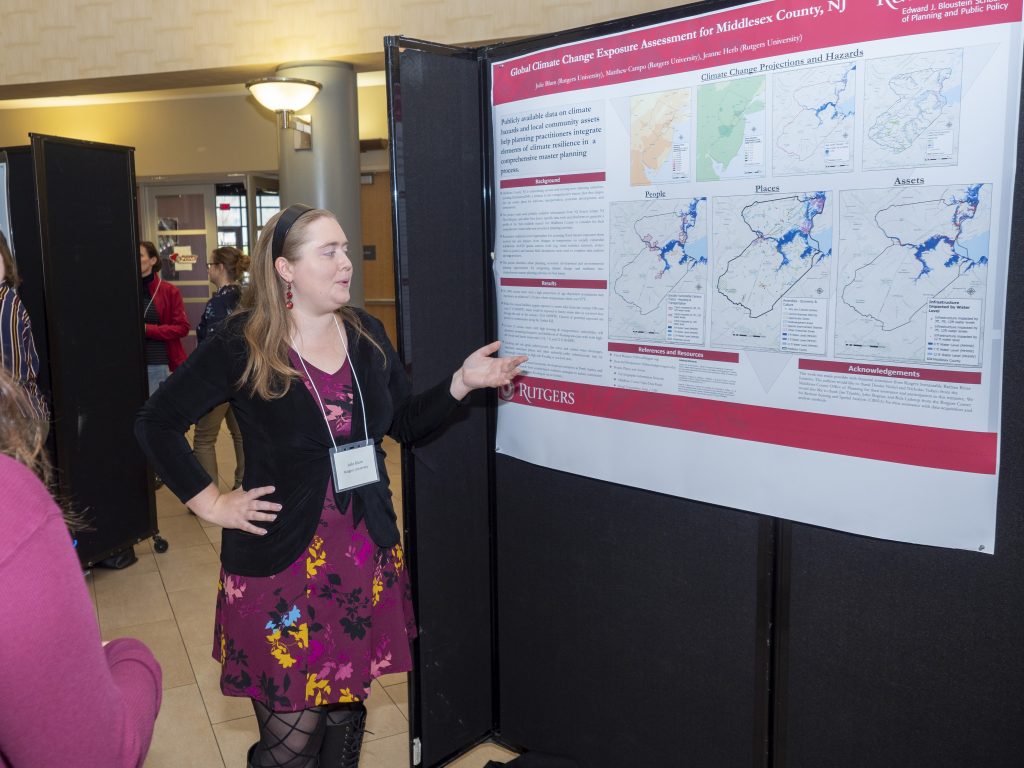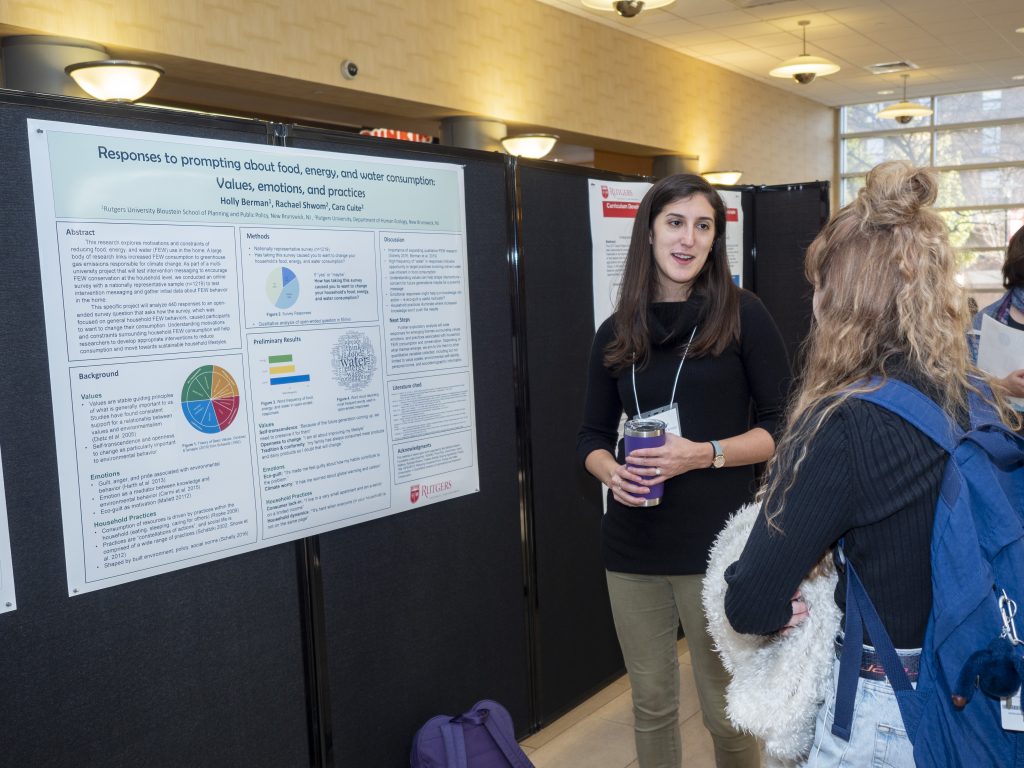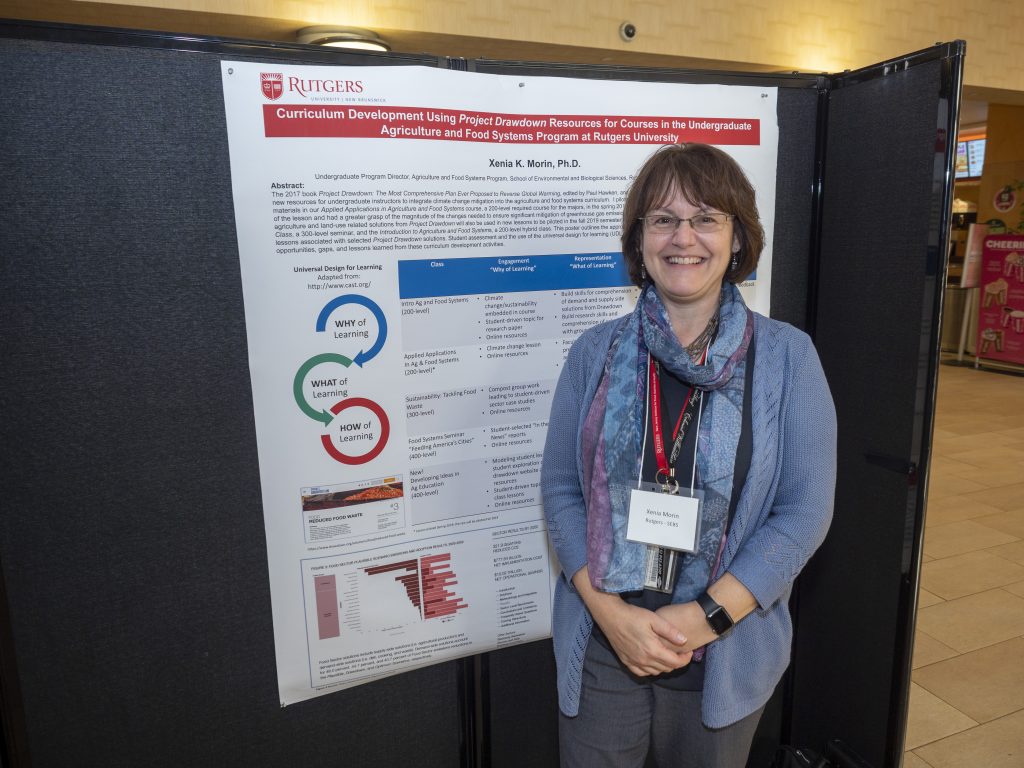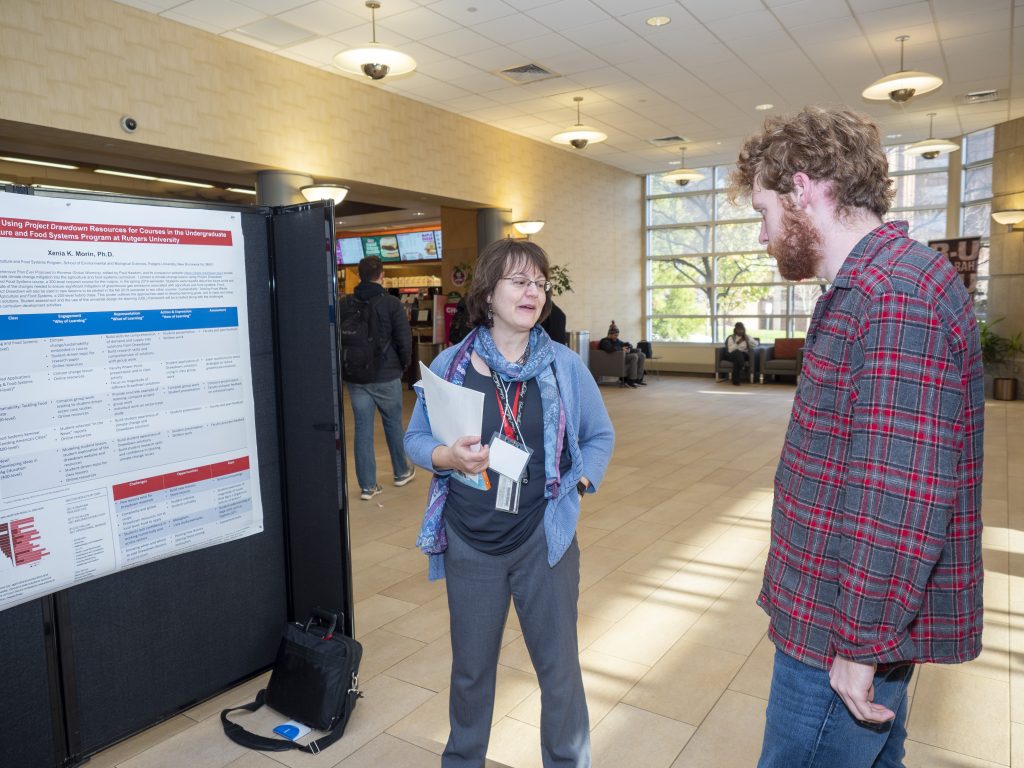Rutgers Climate Symposium 2019
More than 200 students, post-docs, faculty and staff from academic institutions in our region participated in Rutgers Climate Symposium 2018 in which the theme was Science and Society: Perspectives On A Green New Deal. Participants were treated to an inspiring keynote by Naomi Klein, an award-winning journalist and Gloria Steinem Chair for Media, Culture, and Feminist Studies at Rutgers University. A plenary panel included Daniel Aldana Cohen (University of Pennsylvania), Ayana Elizabeth Johnson (Ocean Collectiv), Neil Maher (New Jersey Institute of Technology), and J. Marshall Shepherd (University of Georgia).
Posters were presented by researchers from not only Rutgers but institutions across the region. The event provided an excellent opportunity to foster collaboration on climate change scholarship in our region.
Rutgers Climate Symposium 2019
Science and Society: Perspectives On A Green New Deal
November 20, 2019
AGENDA
8:15 AM Check-In (Student Center Concourse)
Poster Session Set-up (Livingston Student Center Concourse)
Light Breakfast (Livingston Student Center Livingston Hall)
9:00 AM Welcome and Keynote Address (Livingston Hall)
Welcome
Robert Goodman, Executive Dean, School of Environmental and Biological Sciences
Peter March, Executive Dean, School of Arts and Sciences
On Fire: The Burning Case for a Green New Deal. | Presentation PDF
Naomi Klein, Rutgers University
10:15 AM Break
10:45 AM Science and Society Perspectives on A Green New Deal Plenary Panel (Livingston Hall)
Climate Change Lessons from the Old New Deal. | Presentation PDF
Neil Maher, New Jersey Institute of Technology
Ocean Justice and the Blue New Deal. | Presentation PDF
Ayana Elizabeth Johnson, Ocean Collectiv
The Case for a Green New Deal for Housing. | Presentation PDF
Daniel Aldana Cohen, University of Pennsylvania
Is There a Climate Science Case for the Green New Deal? | Presentation PDF
J. Marshall Shepherd, University of Georgia
12:30 PM Lunch (Livingston Hall )
1:00 PM Poster Session (Concourse)
3:00 PM Adjourn
Rutgers Climate Symposium is made possible through the generous support of the
Frank Sposato Memorial Endowment

Naomi Klein
Naomi Klein is an award-winning journalist, syndicated columnist and author of the New York Times and international bestsellers, No is Not Enough: Resisting Trump’s Shock Politics and Winning the World We Need (2017), This Changes Everything: Capitalism vs The Climate (2014), The Shock Doctrine: The Rise of Disaster Capitalism (2007) and No Logo (2000).
Klein is the Senior Correspondent for The Intercept. She is also a Puffin Foundation Writing Fellow of the Type Media Center and contributor to the Nation Magazine. Recent articles have also appeared in The New York Times, The New Yorker, The Boston Globe, The Guardian, the London Review of Books, Harper’s Bazaar, and Le Monde. In September 2018, she was named the inaugural Gloria Steinem Chair for Media, Culture and Feminist Studies at Rutgers University (New Brunswick, NJ).

Daniel Aldana Cohen
Daniel Aldana Cohen is an Assistant Professor of Sociology at the University of Pennsylvania, where he directs the Socio-Spatial Climate Collaborative, or (SC)². Aldana Cohen is also a Member of the Institute for Advanced Study in Princeton, New Jersey (2018-19).
Daniel works on the politics of climate change, investigating the intersections of climate change, political economy, inequalities of race and social class, and political projects of elites and social movements in global cities of the North and South. He's working on a book about housing, inequality, and climate politics in New York and São Paulo, tentatively titled Street Fight: Climate Change and Inequality in the 21st Century City.
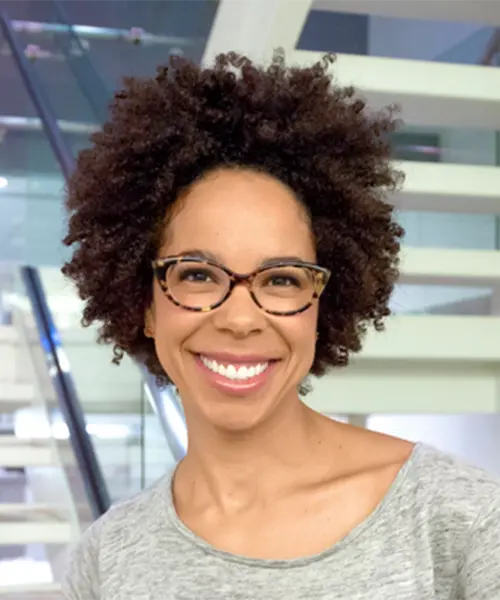
Ayana Elizabeth Johnson
Dr. Ayana Elizabeth Johnson is a marine biologist, policy expert, conservation strategist, and Brooklyn native. She is founder and CEO of Ocean Collectiv, a strategy consulting firm for conservation solutions grounded in social justice. Her new venture is Ocean Policy Lab, a think tank focused on coastal cities. She also holds appointments as an adjunct professor at New York University, as a science scholar at Pioneer Works, and mentors next generation ocean leaders.
Ayana earned a B.A. from Harvard University in Environmental Science and Public Policy, and a Ph.D. from Scripps Institution of Oceanography in marine biology, with a dissertation on the ecology, socio-economics, and policy of sustainably managing coral reefs. For her research, she was awarded fellowships from the National Science Foundation, Switzer Foundation, and American Association of University Women. The fish trap she invented to reduce bycatch won the first Rare/National Geographic Solution Search. She has been a resident at TED, a scholar at the Aspen Institute, and named to the Grist 50 and UCSD 40 Under 40 Alumni.
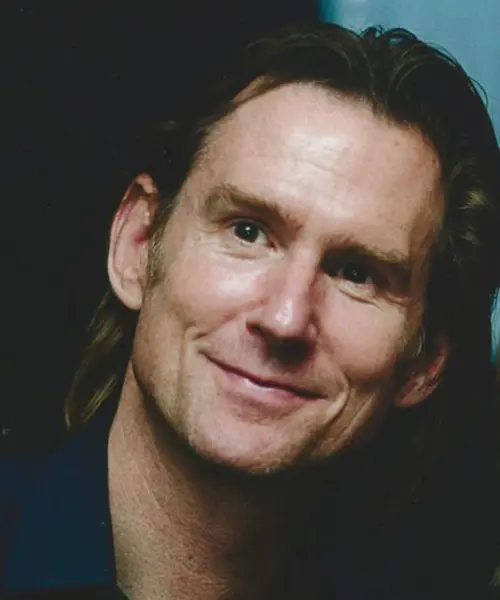
Neil Maher
Neil Maher received his Ph.D. in history from New York University in 2001, and is currently a professor in the Federated History Department at the New Jersey Institute of Technology and Rutgers University, Newark, where he teaches environmental history and political history. Professor Maher has received numerous fellowships, awards, and grants from institutions such as Harvard University, the Organization of American Historians, the Smithsonian Institution’s National Air and Space Museum, and the National Aeronautics and Space Administration (NASA).
In 2009 Neil M. Maher´s book, Nature´s New Deal: The Civilian Conservation Corps and the Roots of the American Environmental Movement (Oxford 2008), received the Charles A. Weyerhauser Award for the best monograph in conservation history. Pinsky is an Associate Professor in the Department of Ecology, Evolution, and Natural Resources and an Alfred P. Sloan Fellow in Ocean Sciences at Rutgers University. He leads a research group studying the ecological and evolutionary impacts of climate change in the ocean, and he developed the OceanAdapt website to document shifting ocean animals in North America. He has published articles in Science, Proceedings of the National Academy of Sciences, and other international journals, and his research has received coverage in the New York Times, Wall Street Journal, BBC, National Public Radio, and other media. He has a Ph.D. from Stanford University, an A.B. from Williams College, and earlier connections along the coast of Maine.
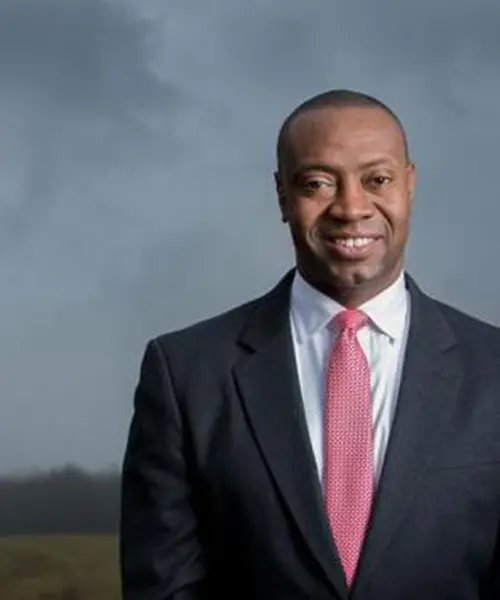
J. Marshall Shepherd
J. Marshall Shepherd is a leading international expert on weather and climate and is the Georgia Athletic Association Distinguished Professor of Geography and Atmospheric Sciences at the University of Georgia. Dr. Shepherd was the 2013 President of American Meteorological Society (AMS), the nation’s largest and oldest professional/science society in the atmospheric and related sciences. Dr. Shepherd serves as Director of the University of Georgia’s Atmospheric Sciences Program. Prior to academia, he spent 12 years at NASA and was Deputy Project Scientist for the Global Precipitation Measurement satellite mission.
Dr. Shepherd is the host of The Weather Channel’s Award-Winning Sunday talk show Weather Geeks and a contributor to Forbes Magazine. His research primarily centers around hydrometeorological extremes, urban climate, and the intersection of weather and society. He has received numerous awards and has been honored at the White House. Dr. Shepherd is frequently sought as an expert on weather and climate by Congress, NASA, the White House, and major media outlets such as CBS Face The Nation, NOVA, The Today Show, CNN, Fox News, and The Weather Channel. His TedX Atlanta Talk on “Slaying Climate Zombies” is one of the most viewed climate lectures on YouTube. Dr. Shepherd received his B.S., M.S. and PhD in physical meteorology from Florida State University.
| Authors | Title | Abstract | Link to the Poster PDF |
|---|---|---|---|
| Eid Alotaibi (Rutgers University), Miklos Vasarhelyi (Rutgers University), Lie Ming Tang (University of Sydney), Qingliang Tang (Western Sydney University) | Using Blockchain for the Management of US Regional Emissions Allowances | The project aims to use new technology, blockchain for the carbon management in the US regional cap-and- trade system: namely California ETS and Regional Greenhouse Gas Initiative (RGGI). The two ETSs in US are deemed successful in terms of carbon reduction and sustainable economic growth in the 11 states that run the system. But GHG emissions control requires coordinated efforts and collaboration at all levels of governmental bodies, non-for-profit organizations and private sectors. However, the target is difficult to achieve due to challenges arising from conflicts of interest and lack of trust between stakeholders under traditional technology. Blockchain is a decentralised and consensus based system which provides reliable data, peer to peer transactions and instantaneous communication between participating parties. Thus, using blockchain technology in the system can significantly enhance trust and confidence and efficiency in the allocation of carbon emissions allowances, trading and surrenders. The adoption of blockchain not only strengthens the market system but also fits the corporate entities that participate the ETS for carbon control purposes. Blockchain-enabled ETS allows continuous carbon monitoring, measurement, reporting, and verification and facilitates integration of operational ETSs and corporate carbon asset management into a synthetic single mechanism. | |
| Nazia Arbab and Jason Grabosky (Rutgers University) | Spatially Explicit Forest Ecological Assessment (SEFEA) Decision Support Tool to Aid in Forest Management and Land Use Planning: New Jersey as a Model Summary | The Spatially Explicit Forest Ecological Assessment (SEFEA) Decision Support Tool is a decision support system (DSS) to assist forest managers in taking an ecologically optimal approach to multipurpose forest management decisions. SEFEA is a web-based tool utilizing existing methods and techniques, including data on various forest attributes, a decision tree for selecting options from a series of choices, and creating multiple statistical outputs and a mapping interface. SEFEA is a multi-disciplinary in nature, and a user-interactive technology with significant linkages to land use change, biodiversity and watershed quality improvement projects. SEFEA tool would help in evaluating the consequences of management plans for forested landscapes in New Jersey. SEFEA employs a user-intuitive approach by incorporating user defined management choices. Management choices within the model structure are based upon what if scenarios and how and where and how long types of scenarios. SEFEA is based upon existing data inventories and projected scenarios to improve the decision-making technological capacity. SEFEA will help forest managers and planners to gain new insights by generating outcomes from a variety of scenarios so that ecologically efficient alternatives and strategies in the decision and planning management process can be evaluated. | |
| Holly Berman (Rutgers University), Rachael Shwom (Rutgers University), Cara Cuite (Rutgers University) | Understanding motivations and constraints of household food, energy, and water conservation | This research explores motivations and constraints of reducing food, energy, and water (FEW) use in the home. A large body of research links increased FEW consumption to greenhouse gas emissions responsible for climate change. As part of a multi-university project that will test intervention messaging to encourage FEW conservation at the household level, we conducted an online survey with a nationally representative sample (n=1219) to test intervention messaging and gather initial data about FEW behavior in the home. This specific project will analyze 440 responses to an open-ended survey question that asks how the survey, which was focused on general household FEW behaviors, caused participants to want to change their consumption. Preliminary analysis reveals that “water” is the most frequently used word (96 mentions), followed by energy (60), and food (57). Terms including “think” (55), “can” (49), and “aware” (31) suggest participant reflection on their consumption habits. Terms like “want” (26), “need” (21), “always” (20), and “habits” (20) may indicate discussion of constraints on behavior change. Further exploratory analysis will code these responses for emerging themes about motivations for and constraints on household FEW consumption and positive/negative emotions associated with FEW consumption and conservation. Understanding motivations and constraints surrounding household FEW consumption will help researchers to develop appropriate interventions to reduce consumption and move towards sustainable household lifestyles. | |
| Joanna Burger (Division of Life Sciences, Rutgers University) and Michael Gochfeld (RWJ Medical School, Rutgers University) | Effects of Sea Level Rise on Nesting Populations of Colonial Birds in Barnegat Bay: 1976 to 2016. | Population levels and concentrations of heavy metal have been examined in Barnegat Bay since 1976. The number of nesting pairs of Common Terns and Black Skimmers decreased significantly, as reproductive success and the number of nesting colonies of each species. Although the number of nesting Forster’s Terns increased until the early 2000s, they have decreased since then. Similarly, the number of nesting Laughing Gulls and Herring Gulls have decreased, although the Great Black-backed Gulls have increased. Great Black-backed Gulls have increased partly because they are significantly larger than the other species and can outcompete ten for space when it becomes limited. The most notable change in habitat suitability for colonial-nesting birds in Barnegat Bay is a loss of habitat, partly to sea level rise. Since 1976, depending upon the species, two to four islands have completely disappeared and on 8 to 13 of the islands the suitable habitat has disappeared (mainly due to severe storms and increased water levels). For still other islands, habitat is suboptimal, and often floods during excessive high tides. Except for mercury, most metals have declined over this same time period. Over the years this research has been funded by USDA NIFA Hatch Multistate project 1008906 through NJAES (Hatch NJ12233), NJDEP, USFWS, and Trust for Public Lands. | |
| Kimberly Callas, M.F.A, (Monmouth University), AR 218 Sculpture 2 Students (Monmouth University), Aslan Youth Ministry Students, Monmouth University Science Students | 2019 Discovering the Ecological Self: TREES | Discovering the Ecological Self (D-Eco-Self) is a Social Practice Art project designed to combat the climate crisis by restoring our personal relationship with nature. Through workshops, D-Eco-Self, works with communities, classes, and non-profits to help people re-discover their intimate relationship with nature by combining scientific data with personal and cultural meaning-making through art. For example, this poster shares a series of D-Eco-Self workshops that were held with Monmouth University students and a local non-profit, Asian Youth Ministry. The workshop focused on trees, threats to their ecosystems and their benefits to the environment. In each workshop, science students gave a talk on the science that is related to the topic, then Social Practice students discussed the topic as a symbol and how people have made meaning from the topic. For example, they might talk about how a seed can represent potential and look at how seeds are represented in artwork, poetry, and in basic language, as in ‘Let me plant this seed...’. We then make art that combines what we learned that day with our personal feelings toward the topic. The idea is to bring together scientific research, meaning- making and emotional connection with nature to inspire environmental stewardship. | |
| Matthew Campo (Rutgers University), Julie Blum (Rutgers University), Jeanne Herb (Rutgers University), Denise Nickel (Middlesex County), Nicholas Tufaro (Middlesex County) | Global Climate Change Exposure Assessment for Middlesex County, NJ | Middlesex County, NJ, is undertaking several mid-to-long-term planning initiatives, including Destination2040, a revision to the comprehensive master plan that shapes how the county plans for land-use, transportation, economic development, and environment. The Rutgers University project team developed an exposure assessment for changes in temperature, precipitation, sea-level rise, and coastal storms for Middlesex County to consider current and future planning initiatives. The project team used publicly available information from NJ Forest Adapt, NJ Flood Mapper, and other New Jersey specific data tools and platforms to generate a profile of the ‘best available science’ for Middlesex County to consider for their comprehensive master plan and associated planning activities. The Rutgers team then worked with Middlesex County to develop an exposure assessment that analyzes how future changes in climate will affect critical people, places, and assets in the region. Researchers employed novel approaches for assessing flood hazard exposures from sea-level rise and impacts from changes in temperature on socially vulnerable populations. This project identifies urban planning, economic development and environmental planning opportunities for integrating climate change and resilience into comprehensive master planning activities in New Jersey. | |
| Isatis Cintron (Rutgers), Peter Kregsamer (TU Wien) Gerelmaa Gunchin (TU Wien), Monica Mazurek (Rutgers), Hinrich Grothe (TU Wien) | Measurements of light absorbing particles impacts in Svítnafelljökull. | Surface snow measurements of light absorbing particles were carried at Svínafelljökull, an outlet glacier of the Vatnajökull Ice Cap (VIC) in southeast Iceland. The average annual rate of mass change of VIC (-1.34± 0.12 m w.e. a−1), during the period of 2002-2010, is one of the most negative mass balance values recorded in the 21st century globally. The Svínafelljökull has retreated 800m and lost 30% of its 1890 volume. Light-absorbing particles, such as black carbon (BC), dust and brown carbon (BrC), alter the optical properties and melt of snow. This impact on snow reflectivity decline can be a major contributor to the regional accelerated melting seen in recent years. Currently, direct measurements of light absorbing aerosols (LAA), specifically BC, are very scarce in high latitudes. Three surface sites were selected for collecting snow surface samples and mobile albedo measurements. Our focus is to investigate how much of the observed change in snowmelt in southeast Iceland can be attributed to the deposition of LAA, such as BC, using the Snow, Ice, and Aerosol Radiative (SNICAR) model. Refractory BC mass concentration measurements using the Single Particle Soot Photometer (SP2) will be discussed. | |
| Sara Elnakib (Rutgers Cooperative Extension), Amy Rowe (Rutgers Cooperative Extension) | Energy and water impacts from a school food waste reduction program | The USDA estimates that 30-40% of the food produced in the US is wasted, which is 133 billion pounds and $161 billion worth of foodwaste each year. 15 Paterson, NJ, schools participated in a school foodwaste reduction study, with the programming based on a behavioral economics program to improve student consumption. Pre- and post-training food waste audits were undertaken, with 2,473 pounds wasted before the intervention and 2,123 wasted after training. Overall, 350 pounds of food were saved, which was a 14% reduction in foodwaste. Approximately 12 pounds of food were saved per school per day and a total of 90,720 pounds of food waste saved for the district for the year. The estimated food cost savings is $76,452 per year. Agricultural production data was used to show the environmental impact of this program. An estimated 42,000 gallons of water were saved due to the intervention, which extrapolates to the conservation of more than 10.5 million gallons of water by the school district over the 180-day school year. An estimated 33 kWh of energy were conserved because of the training implementation, saving more than 250,000 kWh by the district annually. | |
| Alexis Everland (Tall Timbers Research Station), Michael Gallagher (US Forest Service NRS), Scott Pokswinski (Tall Timbers), Kevin Hiers (Tall Timbers), Audrey Wilson (Tall Timbers), Louise Loudermilk (US Forest Service SRS), Julia Defeo (Rutgers University), Megan Rhone (West Virginia University), Nicholas Skowronski (US Forest Service NRS) | Dynamics of Pine Bark Microrelief as a Potential Factor in Firebrand Production | Firebrands or embers are combusting fragments of fuel that can be lofted into a fire’s plume and transported great distances ahead of a fire front, igniting structures or new spot fires. (Caton-Kerr, et al., 2019). Spot fires can become entirely new fires if they are not extinguished quickly, adding to the overall impact, as well as possibly creating dangerous situations for firefighters, such as entrapments (Koo, et al., 2010). A study in the New Jersey Pine Barrens found that 70% of firebrands collected from a prescribed fire were bark flakes (El Houssami et al., 2015). The conditions for firebrands are separation, lofting, and transportation. The structure of bark or its “flakiness” will affect the drag forces acting to separate, loft, and transport it. Fire frequency, size and severity is expected to increase with climate change (Caton-Kerr, et al., 2019), along with factors suspected to create bark structure that promotes firebrand generation, such as temperatures and durations of dryness. This project aims to characterize fine scale bark structure changes at hourly intervals and the effects temperature, moisture, and aspect has on structure. Photogrammetry and infrared photography proved to be effective off the shelf ways for quantifying fine scale bark structure and temperature changes at hourly time intervals. The results of the study indicate that the bark structure of pitch pine can change throughout the day, and is best described as peeling. Furthermore, Moisture and temperature conditions were influenced by wetting, while bark flaking was influenced by aspect. Results of modelling data using a Bayesian multiple regression approach shows that temperature and moisture can be significant predictors of bark peeling, but peeling has a more complex relationship with aspect and treatment. Sampling was repeated on several days during the primary fire season in NJ in May, June, and August of 2019 with several adjustments to the methods. These adjustments were aimed to address the limitations of the 2018 sampling methods: only one species was considered, measurements were only taken on one day not in the primary fire season, and treatment may have been insufficient. Future work in NJ and Florida will explore this phenomenon between Pinus rigida (Pitch Pine) and Pinus palustris (Longleaf Pine). | Poster PDF |
| Carrie Ferraro (Rutgers University), Robert Kopp (Rutgers University), Rebecca Jordan (Rutgers University), Jie Gong (Rutgers University), Clinton Andrews (Rutgers University), Jeanne Herb (Rutgers University), Lisa Auermuller (Rutgers University), Janice McDonnell (Rutgers University), Sally Bond (The Program Evaluation Group) | Coastal Climate Risk & Resilience | In the United States, about 23 million people live within 6 meters of sea level. In many parts of the country, sea-level rise between 1960 and 2010 has already led to a 2-5-fold increase in the rate of ‘nuisance’ flooding. On top of rising seas, intensifying hurricanes and more frequent extremes of heat, humidity and precipitation pose additional risks to coastal societies, economies and ecosystems. Addressing risks posed by changing climate conditions in coastal areas demands innovative strategies that intersect multiple disciplines including engineering, ecology, communication, climate science, and community planning. To be usable, it also requires engaging coastal stakeholders in the development of research questions, the assessment of implications of research for planning and policy, and the communication of research results. Yet traditional, disciplinary programs are poorly configured to train the workforce needed to assess coastal climate risk and to develop and deploy integrated strategies for increasing coastal climate resilience. Coastal Climate Risk & Resilience (C2R2) is an NSF Research Traineeship (NRT) working to prepare the workforce that will build coastal resilience in the face of climate risks. C2R2 trains graduate students who conduct research to better integrate all the elements of coastal systems and to communicate effectively with coastal stakeholders. Through their research and practice, C2R2 graduates will contribute to significantly improved public- and private-sector decision-making in the face of global, regional, and local change. | |
| Michaela Gardiner (William Paterson University), Shana Foster (William Paterson University), Troy Nixon (William Paterson University), Dr. Martin Andrew Becker (William Paterson University), Dr. Harry M. Maisch (William Paterson University) | Surface Collection of Late Cretaceous Shark and Fish Remains from Sandoval County, New Mexico | During the Late Cretaceous, a shallow marine seaway covered a portion of the western United States that includes present-day New Mexico. A diverse assemblage of marine vertebrates including sharks, fish, and marine reptiles inhabited this seaway. Little consensus exists on the taxonomy and chronology of reported species from that area. Our fieldwork and research aims to address gaps in previous studies through detailed field collection, laboratory analysis, museum visitation, and primary literature review. Numerous species of shark, ray teeth and bony fishes were collected, identified, and may overlap with the third order eustatic sea level cyclicity that may have resulted in their concentration into lag deposits. These findings can corroborate previous studies and map the occurrence of New Mexico’s Late Cretaceous shark and fish deposits and correlate them to other contemporaneous locations in the Western Interior Seaway and elsewhere globally. | Poster PDF |
| Laura Geronimo (Georgia Tech / Rutgers) | Puerto Rico Disaster Mitigation and Recovery Studio (Spring 2019: GA Tech & UPR) | Category 4 Hurricane Maria touched down over Puerto Rico on September 20th, 2017, with wind gusts of up to 147 mph (FEMA Hazus Report, 2017). Against a backdrop of ongoing economic malaise, the hurricane caused widespread devastation, resulting in the collapse of critical infrastructure systems. In the aftermath, Puerto Rico continues to struggle for stability, amidst an ongoing humanitarian crisis, which has also affected government functions and economic activity. Given this context, Georgia Tech students and allied faculty interested in Global Development proposed a pilot joint studio between the University of Puerto Rico’s Graduate School of Planning (EGP), and Georgia Tech’s School of City and Regional Planning (SCaRP) focused on disaster mitigation, recovery and socio-economic development. Faculty from both universities ran parallel courses and an exchange program in the Spring of 2019, with the goal of contributing to the island’s long-term recovery and development. This joint studio was funded by the American Planning Association (APA) and is intended to be the pilot in a multi-year collaboration ending with an implementation component. This poster discusses the studio experience and results. This poster was previously presented at the APA 2019 Conference in San Francisco. | Poster PDF |
| Parker Herrera (Rutgers University), Prasiddha Sudhakar (Rutgers University), Tyra Aversa (Rutgers University), and Danielle Heaney (Rutgers University) | Household Consumption and Climate Change: Understanding the Implications of Food Purchases for Greenhouse Gas Emissions | This poster focuses on the development of a household intervention-driven software called HomeTracker, that provides feedback to users about their food, energy, and water intake. We conducted a pilot test of the HomeTracker (N=20) in order to test its usability and identify potential problems prior to use in a larger study the following year. The poster addresses perceptions of the HomeTracker by users who tested it and the methods used to categorize and analyze pilot study data on impacts of food purchases. The United States Environmentally Extended Input Output (USEEIO) modeling framework can then be used to convert food purchasing data to greenhouse gas equivalents. This is useful since, based on consumption patterns, the HomeTracker can provide the individual with intervention messages that contain impacts relating to their habits. These messages aim to reduce consumption of greenhouse gas (GHG) intensive food, water, and energy to hopefully reduce consumption patterns which promote climate change. | Poster PDF |
| Teresa M Jarvis (Villanova University), Dr. Francis A Galgano (Villanova University) | Environmental Security; India the Lynchpin of South Asia | The nature of conflict has evolved and research suggests that the definition of national security needs to include environmental threats to stability. This project examines the relationship between exposure to adverse environmental factors, adaptive capacity, and vulnerability and conflict. The objective is to identify places at risk to conflict triggered by environmental factors. India is a useful case study of the environmental security paradigm because it rests between the developed and developing world. India has a strong GDP, relatively stable governance, and self–sufficiency; nevertheless it faces challenges characteristic to many developing states. This project developed a quantitative, Environmental Security Index (ESI), at global, regional, and state scales to determine places at risk to instability triggered by adverse environmental conditions. The ESI uses a geometric mean to integrate normalized variables into a composite index to identify risk between 0.00 (most) to 4.00 (least). The global ESI indicates that all states are at risk to instability; however, risk is focused in the developing world. The India ESI suggests that extant pressures exist: the provinces of Uttar Pradesh and Bihar are the most vulnerable to conflict along with southern India. Governance factors are better indicators for climate change adaptation. | Poster PDF |
| Jin-Si Over (Rutgers University), Katherine Ames (Rutgers University), Norbert Psuty (Rutgers University), Andrea Habeck (Rutgers University), Lisa Auermuller (Rutgers University), Matt Campo (Rutgers University), John Sousa (Rutgers University), Michael De Luca (Rutgers University), William McBride (NJ Dept Military and Veterans Affairs), Sarah Helble (NJ Dept Military and Veterans Affairs), Steven Hoffman (NJ Dept Military and Veterans Affairs) | Potential Impacts of Climate Evolution and Resilience on Response Capability at New Jersey Army National Guard Sites | Climate evolution has the potential to impact and affect the ability of the NJ Army National Guard to respond to emergencies. A project team from Rutgers University is assessing twelve Army National Guard sites (and their surrounding areas) within New Jersey to determine their exposure from climate stressors including rainfall, temperature, sea-level rise, stream flooding, erosion, air quality, and others. The project team will incorporate the ‘best available science’ to identify the site exposure and risk assessment for time periods of 2030, 2050, 2080, and 2100. Desk-top analysis of the physical facilities and the geomorphological, ecological, and anthropological components of the sites and their surroundings will establish areas and capabilities at risk. A convened panel of experts from Rutgers will review the accumulated data and the projections, and they will reinforce areas of concern and identify gaps in data collection and/or climate impacts. Following site visits and interaction with National Guard sources, Risk Assessment Response Options reports will be generated to document areas of anticipated exposure and options for response. This project represents the first time the impacts of climate resilience are being incorporated into the Real Property Development Plans that are being updated by the NJ Army National Guard. | |
| Pranay Kumar, Cara Cuite, Frank A. Felder, Rachael Shwom; E.J.Bloustein School of Planning and Public Policy, Department of Human Ecology | Evaluating Spillovers from Behavioral Interventions for Food, Energy, Water (FEW) Conservation | Spillover in impact evaluation is commonly known as observable and causal effect that a change in one behavior has on a different, subsequent behavior. In this poster, we present a theoretical framework and research methodology for assessing spillovers from behavioral interventions for food, energy, and water conservation for residential households. To explore the dynamic impact of the interventions, we observe monthly variations of FEW consumptions over a period of one year using randomized control experiment on a sample of about 300 residential households. We intend to access the households’ previous years electricity and water use to construct the baseline and control for demographic profiles for comparison before and after the experiment. We also look at possible behavioral spillover outside FEW domains through self-reported data on biking, use of reusable shopping bags, switching off lights/ac/ thermostat when not required in work-places etc. Most of the previous studies estimate gross impacts of one-time behavioral intervention for food, energy, or water conservation separately. Such findings may result in biased and over/under impact estimates of the intended outcome. This project to assess net impact will add valuable information pertaining to dynamic interactions across food, energy, and water domains for appropriate policy recommendations. | Poster PDF |
| Melanie Kwestel (Rutgers, The State University of New Jersey); Minkyung Kim (Rutgers, The State University of New Jersey) | Organizational Resilience Following Environmental Disaster: The Emergence of the Domino Effect Model | Our study examines the way that NPOs that serve vulnerable populations organize and communicate their way through and environmental disaster. Hurricane Harvey was the second costliest storm in Texas’ history with total damage estimated at $125 billion. The slow-moving hurricane dropped one trillion gallons of water across 1,800 square miles in four days, killing thirty-six people, destroying hundreds of thousands of dwellings and commercial structures. We examined the internal and external actions used by four Houston-based nonprofit networks during 300 hours of site visits. Data collection also included in depth interviews, hundreds of pages of documents including policy manuals, e-mails, announcements, and other communication broadcast through websites and social media. Our analysis shows how formal and informal organizing structures are interdependent and arranged sequentially, creating a domino effect model that depicts the conditions required for ongoing resilience. The study adds to the science of resilience by documenting how individuals, organizations and networks build internal capacities and interact with multiple internal and external stakeholders in definitive patterns as they work toward recovery. | Poster PDF |
| Laura Landau (Rutgers University, Dept. of Geography), Holly Berman (Rutgers University, Bloustein School of Planning and Public Policy), Lindsay Campbell (USDA Forest Service - NYC Urban Field Station), Michelle Johnson (USDA Forest Service - NYC Urban Field Station), Erika Svendsen (USDA Forest Service - NYC Urban Field Station) | Reimagining Civic Stewardship Groups as Climate Adaptation Planners | Cities face unique social and ecological challenges compounded by climate change, including recovery after extreme weather events, access to fresh food and clean water, and sustainable energy generation. This work typically falls to traditionally recognized planners, which we define as academics, state actors, and board-certified professionals. Data from the US Forest Service - NYC Urban Field Station’s 2017 Stewardship Mapping and Assessment Project (STEW-MAP) show that civic stewardship groups play a vital and growing role in caring for the local environment. Not unlike local governments, civic stewardship groups work to sustain and enhance socio-ecological systems. The shared efforts of stewardship combat a broad scope of urban climate impacts, as STEW-MAP responses show that groups tackle issues from ecosystem degradation to human health and social policy. As local civic stewardship groups engage in acts of caretaking and claims making on the environment, planners have an opportunity and responsibility to engage with these groups in collaborative processes. We argue that civic stewards act in a planning capacity and should be considered essential actors as we continue to forge best practices in planning urban environments. | Poster PDF |
| Sasha Leidman (Rutgers), Asa Rennermalm (Rutgers), Rohi Muthyala (Rutgers) | Organic Matter Dependent Sediment Deposition in Supraglacial Stream Channels | Sediment consolidates in supraglacial stream channels and darken the surface of the Greenland Ice Sheet. Little is known about how sediment in these streams is distributed, what causes them to deposit in certain areas, and the impact of sediment on the albedo of the ice surface. Here we present in-situ field observations of a supraglacial stream in southwest Greenland. Through UAV imagery, we show that sediment is mainly distributed in meander bend floodplains that are wetted during daily high flow. Analysis of the grain size distribution of these sediments shows that sediment has an average D50 of 27 ± 5.7 μm. The grain size distribution is applied to a theoretical framework based on the Shield’s criterion to determine the minimum water depth for sediment movement. This relationship is then tested with GPS’ed bathymetry measurements and classified UAV imagery of sediment cover. Theoretical effective critical depths are significantly lower than observed values indicating that organic matter within the sediment causes extensive flocculation. Without this flocculation source, sediment in supraglacial streams would not deposit within floodplains. The relationship between stream slope and depositional areas may be applied to a wide range of supraglacial streams on the ice sheet and help infer sediment cover across the Greenland Ice Sheet. Understanding the dynamics of sediment deposition in supraglacial systems is vital for constraining the variability of albedo on the Greenland Ice Sheet and this research will give a process-based framework for how the spatial distribution of stream albedo might change in response to increased melting. | |
| Lauren Madden (The College of New Jersey), Nathan Magee(The College of New Jersey), Louise Ammentorp (The College of New Jersey) | Climate Change and Science Teaching in K-8 Settings | If we are to create a scientifically-literate populace prepared to build solutions to the problems we face related to climate change, then children, as future decision makers and voters, must be prepared with the appropriate knowledge and tools. Though New Jersey has adopted the Next Generation Science Standards (NGSS), which include specific guidance for teachers on topics related to climate change, the degree to which they have been implemented in K-8 classrooms varies considerably (Haag & Megowan, 2015; Harris et al., 2017). Further, climate science is sometimes viewed as controversial, and is an area in which teachers lack content knowledge; as a result teachers lack strategies for addressing climate change in their instruction (Hestness et al., 2011; Hestness et al, 2014; Plutzer et al., 2016). This poster will present NGSS-aligned strategies for addressing climate change in K-8 classrooms through the use of scientific argument and explanation. We will also map out plans for future professional development efforts geared toward current and future K-8 teachers in New Jersey. | Poster PDF |
| Morgan Mark (Rutgers University) | Building a Better Future: Using Green Infrastructure to Improve Urban Resilience | The debate is no longer over the existence of climate change; the contention now lies in developing the most effective mechanisms to impede the progression of and adapt to global warming’s consequences, including changing weather patterns. Increased rainfall could significantly impact runoff volume and water quality in metropolitan areas reliant on combined sewer systems (CSS) and concrete infrastructure. Due to the fact that CSS indiscriminately divert storm- and wastewater to treatment facilities and the re-percolation of precipitation is considerably hindered by impervious surfaces, heavy rain often overloads a CSS and causes a combined sewer overflow (CSO). CSOs are dangerous because they result in floods and effluent discharge into local tributaries, threatening recreation, biodiversity, and human health. One measure that can enable municipalities to reduce their environmental impact and enhance their resiliency despite changing global conditions is implementing green infrastructure (GI), specially designed structures that preserve services like flood control and water purification. London and New York City have already acted to mitigate CSO-associated problems by constructing GI capable of retaining water, ultimately preventing its introduction into the CSS. Encouraging the ubiquity of GI by drawing on previous successes can provide a solution to water derogation stemming from climate change. | Poster PDF |
| Austin Martin (Temple University) | The Native Bees of Metropolitan Detroit: How Demographics Relate to Bee Diversity | Insect pollinators, important for ecological functioning, are seeing declines due to habitat loss, agricultural intensification, pesticides, and pathogens. The community structure of bees and other pollinators in urban areas is under-studied but important for understanding pollinators and their crucial ecosystem services in an increasingly urbanized world. Furthermore, given the coming ecological realities of climate change and increasing global urbanization, understanding the nature of cities insofar as they act as havens for bees and other pollinators is a crucial endeavor. Demographic trends across cities have been shown to affect weed coverage, which in turn affects bee abundance. Cultural norms, municipal codes, lawncare, and aesthetic preferences which influence pesticide usage and the diversity of plants change with a range of socioeconomic trends. Specifically, those with more valuable homes tend to use more bee-harming pesticides. In this study, I compare income and race data from the U.S. Census American Community Survey (ACS) with native bee genus diversity from samples I collected in 2016 throughout Metropolitan Detroit. My research question is how do socioeconomic variables affect native bee genus diversity in changing cities? | Poster PDF |
| Kyle Mattingly (Rutgers University), Thomas Mote (University of Georgia) | Atmospheric rivers contribute to Greenland Ice Sheet mass loss | Among the most pressing consequences of recent climate warming is the acceleration of mass loss from the Greenland Ice Sheet (GrIS) since the late 1990s. Several episodes of widespread GrIS surface melt in recent years have coincided with intense poleward water vapor transport in narrow plumes called “atmospheric rivers” (ARs), suggesting that these events play an important role in high-latitude warming. Climate model projections indicate that poleward moisture transport will intensify as a consequence of anthropogenic climate change. In this work, the impact of poleward moisture transport by ARs on the GrIS is comprehensively assessed from a local- to planetary-scale energy and mass balance perspective. Strong summer ARs are found to cause intense melt events, particularly in western Greenland. ARs produce ice sheet surface melt in cloudy, windy conditions in the area of AR “landfall” and in clear-sky downsloping flow in areas separated from the AR landfall by the topographic barrier of the ice sheet. Moisture fluxes during ARs originate from lower-latitude evaporative sources compared to typical conditions, with enhanced moisture uptake occurring over a broad swath of the Atlantic Ocean during summer and winter, as well as northeastern North America during summer. | Poster PDF |
| Xenia K Morin (Rutgers University) | Curriculum Development Using Project Drawdown Resources for Courses in the Undergraduate Agriculture and Food Systems Program at Rutgers University | The 2017 book Project Drawdown: The Most Comprehensive Plan Ever Proposed to Reverse Global Warming, edited by Paul Hawken, and its companion website (https://www.drawdown.org/) provide new resources for undergraduate instructors to integrate climate change mitigation into the agriculture and food systems curriculum. I piloted a climate-change lesson using Project Drawdown materials in our Applied Applications in Agriculture and Food Systems course, a 200-level required course for the majors, in the spring 2019 semester. Students were hopeful about the future at the end of the lesson and had a greater grasp of the magnitude of the changes needed to ensure significant mitigation of greenhouse gas emissions associated with agriculture and food systems. Food, agriculture and land-use related solutions from Project Drawdown will also be piloted in the fall 2019 semester in other courses: Sustainability: Tackling Food Waste Class, a 300-level seminar, Introduction to Agriculture and Food Systems, a 200-level hybrid class and a new 400-level agricultural education class, Developing Ideas in Ag and Food Education. This poster will outline the approaches used to develop lessons associated with selected Project Drawdown solutions along with a universal design for learning (UDL) framework. | |
| Rohi Muthyala (Rutgers University), Asa Rennermalm (Rutgers University), Sasha Leidman (Rutgers University), Matthew Cooper (University of California-Los Angeles), Sarah Cooley (Brown University) and Laurence Smith (Brown University) | Understanding supraglacial stream network in southwest Greenland | Meltwater on the Greenland ice sheet surface is routed through supraglacial streams and river networks before descending into moulins and crevasses. These networks impact the timing and amplitude of moulin discharge which in turn may influence basal sliding and ice motion. However, despite its importance, surface routing through these stream networks is poorly understood. In this study, we collected 45 discharge measurements and continuous water level stage measurements from 13 June – 13 August 2016, which provide an unprecedented record of stream flow within a ~0.53 km2 supraglacial catchment near the ice sheet margin in southwest Greenland. We calculate a robust rating curve (R2 = 0.928) relating stage to discharge, revealing discharge variations from 0.0-1.0 m3/s with a peak in mid-July. Changes in the efficiency of meltwater transport of the supraglacial stream network were investigated using amplitude and time to peak of the daily stream hydrograph. Model studies show that large amplitudes and early peak times characterize a well-developed stream network when meltwater is evacuated quickly from its origin to the outlet. In our study, we found that the amplitude of daily discharge increased from 0.2 m3/s in mid-June to 0.8 m3/s in mid-July, followed by a continuous high plateau until month’s end and a gradual decrease starting early August. Time to daily peak discharge decreases by 2 hours from mid-June through the end of July. These results suggest that the stream network efficiency has marked seasonal variation and peaks in mid to late July near the ice sheet margin in southwest Greenland. Understanding seasonal changes in the efficiency of supraglacial stream network is vital for determining the impact of surface mass balance on ice dynamics and should be incorporated into ice sheet models to accurately predict the short-term timing of Greenland's contributions to sea-level rise. | |
| Troy Nixon (William Paterson University, Lamont-Doherty Earth Observatory), Kaytlynn Knyfd (William Paterson University), Austin Degen (William Paterson University), Jonathan Harris (William Paterson University), Nicole Davi (William Paterson University, Lamont-Doherty Earth Observatory), Michael Griffiths (William Paterson University), Michael DaSilva (William Paterson University), Jessica Geary (William Paterson University, Lamont-Doherty Earth Observatory), Jordan Raphael (Fire Island National Park Service), Jodi Forrester (N.C. State University) | Tracing Storms and Climate Change Through Tree-Ring Growth Patterns on Coastal Maritime Forests | This project focuses on coastal maritime forests located in Sandy Hook, New Jersey and Fire Island, New York, in an attempt to understand how local forests have been responding to climate change while also looking for evidence of ring damage due to impacts from severe storm events and saltwater inundation. Due to anthropogenic climate change creating more severe storms and rising sea levels, this study has become increasingly relevant and important in creating necessary foundational research on these unique forests. We have collected cores from four dominant species amongst the two locations. After prepping the cores, we examine them using a high-resolution scanner and CooRecorder, a computer program used to measure tree-ring width and density. We are constructing a master chronology using rigorous cross-dating techniques, and will use the site-specific meteorological data to determine the climate signal. We will also evaluate the isotopic composition of each ring in several of the older tree specimens in order to better understand the atmospheric dynamics that resulted in their growth and the relationship to major storms. Some of these trees date back to the mid 1800’s and would provide extended insights into storms frequency in this region. | |
| Xiang Ren(1,2), Ting Cai(1,3), Zhongyuan Mi(1,3), Leonard Bielory(3), Panos G. Georgopoulos*(1,2,3,4,5); 1. Environmental and Occupational Health Sciences Institute (EOHSI), Rutgers University; 2. Department of Chemical and Biochemical Engineering, Rutgers University; 3. Department of Environmental Sciences, Rutgers University; 4. Department of Environmental and Occupational Health, Rutgers School of Public Health; 5. Department of Pharmacology, Rutgers Robert Wood Johnson Medical School). *Corresponding Author: Panos Georgopoulos | Regional Differences of Climate Change Impacts on Population Co-exposures to Ozone and Allergenic Pollen Across the Contiguous United States | The prevalence of Allergic Airway Disease (AAD) is growing globally, resulting in increased numbers of emergency department visits and hospitalizations. Clinical studies show that AAD can be exacerbated by the synergistic action of aeroallergens such as pollen and spores, and atmospheric pollutants such as ozone. Previous studies, involving data from nationwide observations of airborne pollen counts of selected plant species in conjunction with climatic factors, indicated that the start date and length of pollen season, the average peak value and the annual total of daily airborne pollen counts have been affected by the changing climate. The present study investigates changes of pollen indices (Start Date, Season Length, etc.) and ozone indices (Peak Value, Standard Exceedances, Mean, etc.) during 1994-2010 in the nine climate regions of the contiguous United States (ConUS). The associations between these indices are explored using a correlation chord plot, simple/multiple linear regression, and a linear mixed effects model. It is shown there is significant positive association between ragweed pollen season length and ozone peak value in six of the nine climate regions of the ConUS. Analyses of observed pollen counts and ozone concentrations at 58 pollen monitor stations were conducted. Also, concentrations of pollens in base years (2004) and future years (2047) were simulated with a customized version of CMAQ (the Community Multiscale Air Quality model) employing a grid with 36 km by 36 km horizontal resolution, while corresponding ozone concentrations at the same resolution for the above timeframes were estimated by a multi-university/agency consortium including USEPA. This study employed spatiotemporal correlation analysis to examine patterns of co-occurring ozone and pollen concentrations; the outcomes of this analysis provide information that can support development of strategies for managing health impacts of co-occurring photochemical pollutants and aeroallergens. | |
| Nathaniel Schmidt (Penn State University), Jesse Kreye (Penn State University), Julia Defeo (Rutgers University), Michael Gallagher (US Forest Service) | Effects of wildland fire on tick habitat and abundance in the NJ Pinelands | Medically important ticks have been expanding northernly with increasing winter temperatures and are associated with at least sixteen known human illnesses. The northeastern United States is a hotspot for many tickborne diseases, notably Lyme disease, and these diseases are becoming increasingly problematic. Although medical treatments have been effective at treating many of these diseases, undiagnosed or asymptomatic cases can cause future complications and illness, and prevention has mostly taken forms in aracacides, pathogenic fungi, and vegetation manipulation (herbicides or mechanical). These prevention methods, among new developments and host manipulation, are often impractical or limitedly applicable to landscapes or natural ecosystems, however prescribed fire may provide a useful tool for tick management in NJ. This study looks to evaluate how fire regimes affect tick populations, forest vegetation, and microclimates of selected NJ pinelands in Burlington and Ocean counties. Evaluating preliminary data, there appears to be decreasing tick abundance, increasing average temperatures, and decreasing humidity associated with increasing burn severity. Future analysis will include duff depths, vegetation composition, vegetation structure, disease presence, and a second season of sampling (2020). Inclusion of these data sources should better elucidate the potential of fire to mitigate growing tick populations and their associated diseases. | Poster PDF |
| Prasiddha Sudhakar (Rutgers University) | Fighting climate change using technology | This poster focuses on a household intervention-driven software that collects data from and provides feedback to research participants regarding the impacts of food, energy, and water consumption. This is a part of an interdisciplinary project called “Reducing Household Food, Energy & Water Consumption: A Quantitative Analysis of Interventions and Impacts of Conservation.” Building on a version created by a partner university, the HomeTrackerV2 is being designed to parse grocery receipts using Python libraries and machine learning, and uses the utility API to document and store individual food purchases, monthly energy and water consumption. Built using React – a JavaScript Library that can be used to create web and mobile applications – our revised program will be able to target a larger audience using one framework. Based on consumption patterns, the HomeTracker analyzes users’ consumption patterns and provides intervention messages to green consumption and minimize waste. In addition, given prior user consumption patterns and predictors of those patterns, predictive models will be built using machine learning to better predict what the user may consume next, as well as be able to send out more personalized messages regarding their FEW usage. This poster identifies improvements, their benefits and the technical challenges it poses. | |
| Jing Xiao (Rutgers), Asa K. Rennermalm (Rutgers), Sasha Leidman (Rutgers), Federico Covi (University of Alaska Fairbanks), Regine Hock (University of Alaska Fairbanks), Kierin Rogers (Rutgers), Mike MacFerrin (University of Colorado at Boulder), Marco Tedesco (Columbia) | Small-scale variability of meltwater refreezing in Southwest Greenland Ice Sheet firn | Ice lenses formed from meltwater refreezing in firn can prevent further infiltration and increase surface runoff. Most previous studies in Greenland use a single core to represent the refreezing pattern at each site and the small-scale variability within each location is not studied. To better understand the spatial distribution of meltwater refreezing, we present thirteen cores drilled at six sites in SW Greenland in 2017-2018. Through analyzing the thickness and distribution of ice lenses in each core, we see that ice content, maximum, and average thickness of ice lenses decrease with increasing elevation. However, the local variability of these measurements at the sites with multiple cores overlapped with the data range of sites at as much as 250 meters higher/lower elevation. Also, depths and thicknesses of the majority of individual ice lenses in one core appear uncorrelated with depths and thicknesses of ice lenses in other cores at the same site. One exception is that several pronounced ice layers with similar widths and depths are traceable across six cores drilled at one site. This research shows that single cores can provide data of bulk statistics and dominant ice layers which appear to be more evenly distributed at a site. | |
| Lu Zhang (Rutgers University), Qingliang Tang ( Western Sydney University), Miklos Vasarhelyi ( Rutgers University) | Continuous Carbon Auditing | Scientific consensus has emerged that the threat of global warming is imminent due to the intensified anthropocene carbon emissions (GHG, greenhouse gas). Thus, the ongoing measurement, reporting and verification (MRV) of carbon emissions is urgently needed. However, the current mechanism for MRV is on a per annum basis which is inadequate for the timely decision-making of users. This paper aims to propose a new system on continuous MRV integrating new technologies such as blockchain, smart contract, artificial intelligence and interactive data visualization, etc. Draw on the classic continuous auditing (CA) structure (Vasarhelyi and Halper, 1991), we extend the concept of CA into a carbon accounting paradigm, which report carbon footprint and carbon related transactions on a real time basis. The emissions and its related transactions may generate a carbon asset or liability. We will introduce an innovative concept, “carbon coin” (or carbon index) to measure the intrinsic value of the underlying carbon assets and liabilities. The information (using blockchain) is automatically verified and real time which allows a direct monitoring and control of carbon emissions. A P2P communication under the system will improve efficiency of climate change management. | |
| Keyi Zhao (Rutgers Business School), Hanlu Fan (Western Sydney University), Qingliang Tang (Western Sydney University) | You Cannot Manage It, If You Are Not Aware of It: A Study on Climate Change Risk Awareness and Management | This research aims to test whether companies with higher climate change risk awareness adopt more proactive actions in managing climate change risks using data on S&P 500 companies from 2011 to 2017 disclosed in CDP project. Corporate climate change risk awareness will be measured by numbers of risk drivers (regulation, physical and other risk drivers). We will further measure the degree of impact of climate change risks using variables such as likelihood, financial impact, and magnitude of impact. Next, we will measure carbon management practices from several aspects including climate strategy, targets, incentives, and initiatives, etc. Finally, we will test whether our measure of corporate risk awareness and perception are linked with its climate actions and management. The research will contribute to current literature in many ways. Firstly, this is the first research focusing on how risk awareness affects carbon management and carbon performance in a US setting. Secondly, the practical implication is US Congress is proposing a Climate Risk Disclosure Act of 2019. Our study will help evaluate whether it is beneficial to mandate climate change risk disclosure and provide potential policy implications. |





